From
my recent diary
2023
Mainly, I use
the following materials since the end of October, 2018.
Telescope: D: 45.5cm f: 2037mm
Dobsomian (Newtonian reflector)
Eyepiece: and magnification: Lavendura
63mm, apparent FOV 45 deg. with Paracorr
x37, actual FOV 1.2 deg.
Night Vison: ACT
PVS-14 Photonis 4G INTENS 1800 Auto gate P45 WP
Saturday, December 30
I conducted comet hunting sessions six times in December. Three out of
six was moonlight nights, and at one out of the other three moonless
nights the seeing was extremely poor due to strong wind. The star image
was swelled and I could not calmly sweep the sky even if I used Night
Vision (NV) with the magnification of 37. Only two nights, Monday 18 Dec.
and Sunday 24 Dec., I was satisfied with the sweeping the sky. On Sunday
18, the air temperature dropped to -8ºC and it was very cold.
Nevertheless, wind has great impact on the temperature that one feel; I
felt colder on 13 Dec. with strong wind under the air temperature of 5ºC
than on 18 Dec. On Sunday 24, I had a satisfactory searching under a good
transparency and seeing, although the air temperature was -6ºC.
Comet 62P Tsuchinshan 1 became bright. I drew the image of the comet
observed on 18 Dec. after I got home. The comet looked brighter and larger
using the glass eyepiece (the sketch on the left) than using NV. I
estimated the comet as the magnitude of 8, the diameter of 7’, DC=5, and
the tail length of 0.3º with the glass eyepiece, while the magnitude of 9,
the diameter of 3’, DC=7 and the tail length of 3’ with NV. The values
were determined by intuition, not using comparison stars. On the tail, not
only the length but also the direction differs between the two eyepieces.
The ion tail seemed to be observed using the glass eyepiece but the dust
tail did using NV. The dust tail was clearly seen but the ion one was very
faint.
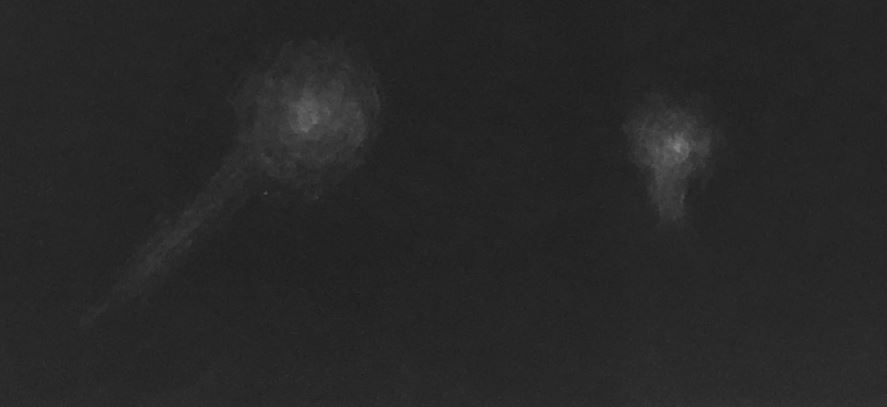
Sketch of 62P Tsuchinshan 1. The sketch was drawn after I returned home
before I forgot the impression remembering what I observed at the
observing site. Left: 46 cm, 78x (Planokular 30 mm + Paracorr). Right: 46
cm, Night Vision (NV) 37x (Lavendura 63 mm + Paracorr). The scales of the
sketches are the same, though the magnifications at the time of
observations were different. The tail extends lower left in the sketch
used the glass eyepiece; the direction coincides with that shown in
SkySasfari 7 Pro.
December 18 4:34 JST (17.816UT). The zenith is down.
The difference in the brightness of 62P measured the glass eyepiece and NV
became smaller on 24 Dec. than on 18 Dec. but the comet still looked
brighter with the glass eyepiece. The direction of the tail was the same
between the two eyepieces, though it differed on 18 Dec.
On the hunting session on Sunday Dec. 24
I usually sweep near the ecliptic. However, this time for a change of
pace, I started the search at Omega Centauri, NGC5128. The cluster that I
observed before the searching session using NV with the magnification of
37 was very impressive; the cluster resolved into many stars stunningly.
Contrary, it did not with the glass eyepiece that I used for the hunting
session (Ethos 21 mm, 97x).
Omega Centauri was only 2.6º above the horizon when I began to search at
5:02am local time. I trained my telescope at the altitude of some 35º and
moved it down toward the horizon. Soon after, M68, a globular cluster in
the constellation of Hydra, came into the field of view. After reaching
the horizon, I rotated the telescope slightly counterclockwise (some 0.2º)
and swept the sky from the altitude of around 30 to 35º toward the horizon
again. Then, I identified PGC43642, a galaxy in Hydra and I estimated the
magnitude as 11th, while SkySafari 7 Pro indicated the magnitude as 11.6
and Guide 9 indicated it as 12.5. I wondered why NGC catalogue does not
include such a bright galaxy. At 5:18am, Centaurus A (NGC5128) was
majestic in the field of view. Even though the altitude of the object was
only 8º above the horizon, the dark lane was clearly seen. Many years have
passed since I observed this object last. The next galaxy I identified was
PGC43456. SkySafari 7 Pro and Guide 9 displayed the magnitude as 12.4 and
13.6, respectively, however, this galaxy is also not included in NGC
catalogue. There are many bright galaxies that are not listed in NGC
catalogue around here.
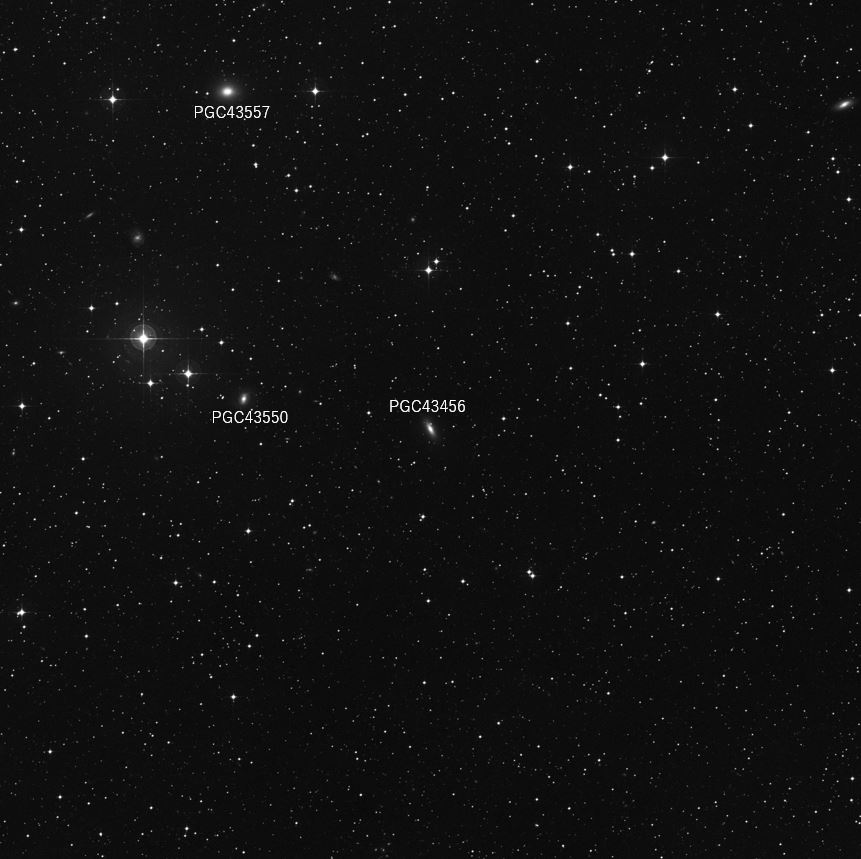
PGC43456. Bright galaxies PGC43550 and PGC43557 were not identified during
the searching session. The image is 1º wide.
The Digitized Sky Survey copyright © 1994
During the session, I confirmed 16 deep sky objects in total. If one aims
the telescope at the area where one usually does not search, one has a
chance to be enjoyable to observe objects that one does not see for a long
time or encounter unexpectedly. After I completed the hunting session, I
trained my telescope at M13 that rose the brightening northeastern sky.
The cluster resolved into hundreds of stars thanks to good seeing. The sky
situation that varies daily and with each passing moment also moves us.
Wednesday, November 22 and Saturday, November 25
I have comet hunted seven times this month. Air temperature changed
drastically this month from 12ºC on November 4 (local time) to -2ºC on
November 25 when it was windy and very cold.

Starlink satellites around Venus. SkySafari 7 Pro.
I always saw many bright artificial satellites near Venus while I was
setting up my telescope, i.e., about one and half hour before the start of
the twilight, since October. They were as bright as -3 to -2 in magnitude,
and they grouped. I tried to identify them using star map applications,
but none of the candidate satellites were bright enough to see by naked
eyes. I think actual brightness differ from the data in the apps. To
identify the satellites, one needs to compare the display and the actual
star field at the site. However, I believe they are Starlink satellites.
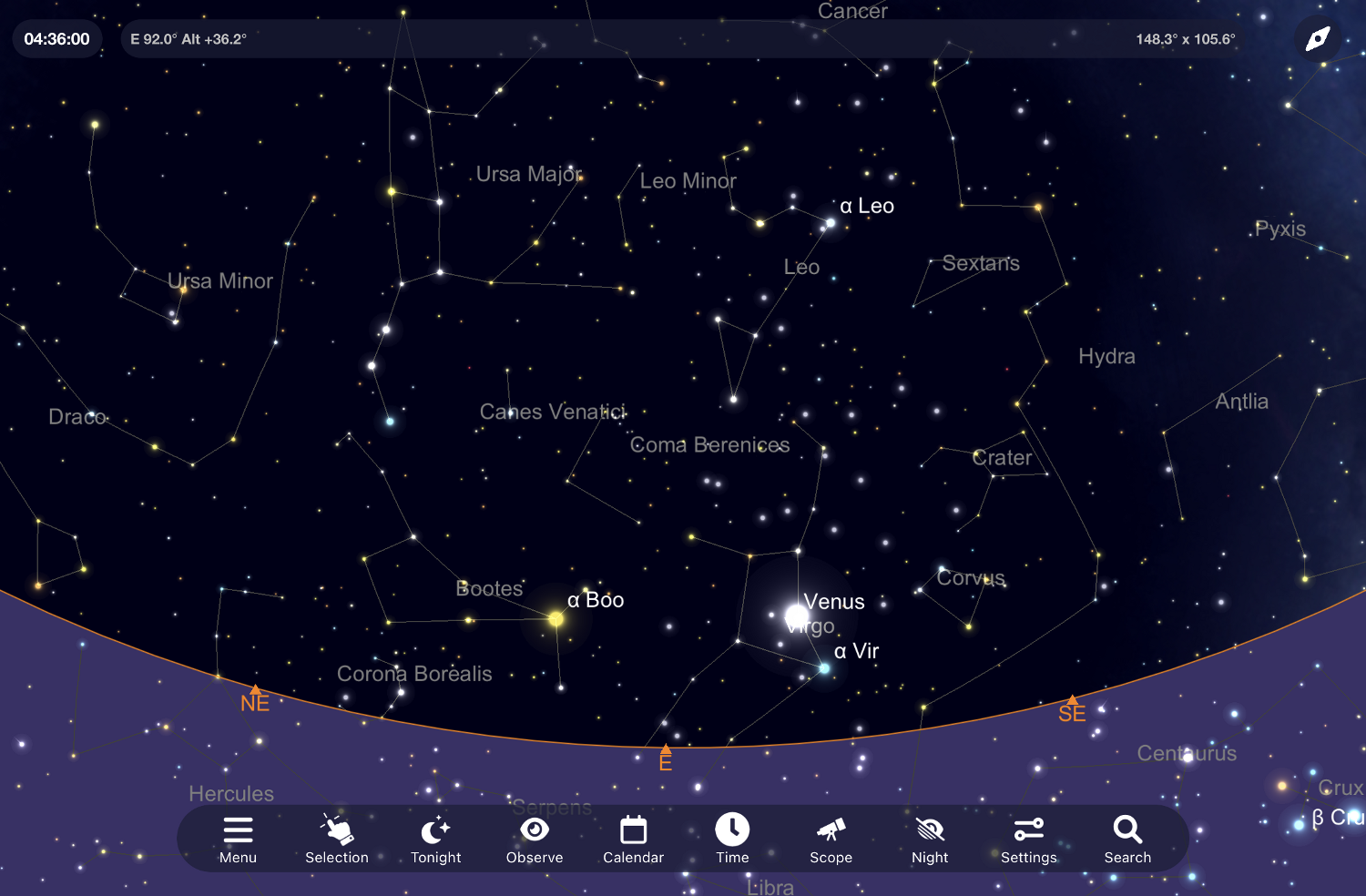
Eastern sky at start of the searching session. SkySafari 7 Pro.
Both on November 22 and 25, I began to sweep the sky from Venus. The arc
that start from the handle of Big Dipper to Arcturus and end at Spica is
called the Great Spring Arc in Japan. The diamond shape formed by
connecting Denebola and this curve is Spring diamond. The shine of Venus
boosts the diamond more brilliant! How impressive the sky was!
I used Night Vison (NV) both nights. Recently, I comet hunted using glass
eyepieces but I applied NV on November 22, because the sky was very hazy
with poor transparency. On November 25, seeing was extremely bad and I
wanted to reduce the magnification. That was the reason why I used NV. The
magnification of NV is 37x, while that of glass eyepieces is 78x or 97x.
I identified 48 galaxies in total on November 22, and 32 on November 25.
The first five galaxies out of 32 that I observed on November 25 from the
start of the session are as follows: NGC4420 (also registered as NGC4409),
4666, M61 (the spiral structure was clearly seen by direct vison!), 4536,
4753. However, I overlooked NGC4420 and 4536 on November 22.
There are some possible causes. Firstly, the star field moved in the field
of view due to diurnal motion because I spent long time to identify many
galaxies, and overlapping of the filed of view was not enough, though the
situation was the same on both days. Secondary, seeing was poor on
November 25 that made it difficult to distinguish stars from galaxies.
Thirdly, I cloud concentrate on observing on November 22 with air
temperature of 6ºC and windless condition, while I was bothered severe
weather with air temperature of -2ºC and windy on 25.
As I mentioned above, the number of detectable galaxies and deep sky
objects are different, if one sweeps the same area using the same
instrument. Air transparency, seeing, the effect of coldness on one’s
body, and health and mental conditions that are independent of outer
environment. I realized all affect discovery of comets.
Tuesday, October 31
I comet hunted ten times this month. Contrary, I did only twice in
August and September because of nasty weather. In addition to that, I
searched five consecutive nights from Sunday 22 to Thursday 26.
I used Night Vision only three nights out of ten when it was moonlight,
poor transparency or seeing. The other seven nights I swept the sky using
glass eyepieces (Ethos 21 mm or Planokular 30 mm with Paracorr).
A couple of years ago, I noticed that the way I see a streetlight in the
distance was quite different between my right eye and left one on my way
to the observing site. The streetlight blurred in my left eye. I went to
the ophthalmologist and he said I had intermediate stage glaucoma. He said
usually it was difficult to notice by myself at this stage. The doctor
said he was impressed how well I found it. According to modern medicine,
the basic treatment is to stop the progression of the disease by keeping
the intraocular pressure low with eye drops, and not to recover from it.
The disease does not affect my comet hunting activity, because my dominant
eye is right. Anyway, I kept the eye drops on. However, side effects came
out one after another, and I was forced to change eye drops four times. At
present I stop using eye drops as the side effect appeared the fourth
medicine.

Wood chip of the eye drop tree, Acer maximowiczianum. 500 g
A month ago, I found wood chip of the tree of eye drop at a shop, which
used to be used for eye treatment. Three grams of the chip was in the tea
pack. I purchased it and had as a tea. I felt that my eyes were less tired
and that my eyesight has improved. For this reason, I bought a 500-grams
chip of the eye drop tree, and keep drinking.
Getting back to the main story. I have ever identified 15th magnitude
objects, i.e. galaxies, only once or twice. I have never done in Niigata
Prefecture, probably because of poor seeing. In Kumamoto, seeing is better
than that in Niigata. Having said so, I could spot 15th magnitude galaxies
only when transparency was fairly well.

PGC34385 and UGC6292. The image is 30’ wide.
The Digitized Sky Survey copyright © 1994
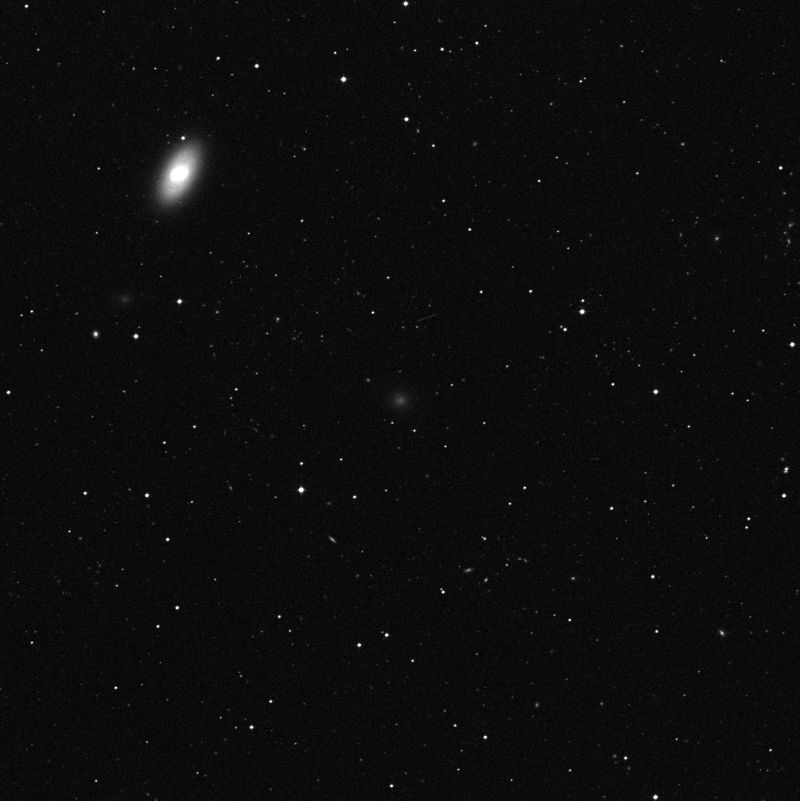
NGC3412 (upper left) and UGC5944 (center). The image is 30’ wide.
The Digitized Sky Survey copyright © 1994
At 5:11am October 19, I identified two 15th magnitude galaxies in the
constellation of Ursa Major, PGC34385and UGC6292, at an altitude of 32º.
At that time, 10 minutes had passed since the beginning of the twilight.
The ocular was not Night Vison, but a glass eyepiece, Planokular 30 mm
with Paracorr. I could not believe that I identified the 15th magnitude
objects because transparency was not so good. However, they really were
15th magnitude, since two digital maps, SkySafari and Guide 9, indicated
them as the 15th magnitude galaxies.
At 4:13am October 25, 10th magnitude galaxy, NGC3412, and fainter one,
UGC5944, in the constellation of Leo came into the field of view side by
side. I checked the brightness of UGC5944 and it turned out to be 15.52
and the altitude was 23º. Surprisingly, the galaxy was only 5º apart from
the ecliptic, that is to say the object was in the zodiacal light. I have
never identified 15th magnitude galaxy under such a bad condition, i.e. in
bright ecliptic light.
I must say the reason why I could see those objects was improvement of my
eyesight due to the eye drop tree. I am going to the ophthalmologist soon,
and I would like to propose the doctor to stop using the eye drops and to
take a look.
Still, it was strange that I could not spot a bit brighter galaxy, like
13th to 14th magnitude. I do not think I will have different results if I
continue to sweep the sky. I am glad to recover my eyes, but I wonder what
is going on.
Saturday, September 30
Usually, the weather is bad in September. According to my record, the
number of days I conducted comet hunting sessions at predawn with clear
sky was zero in 2018, three in 2019, four in 2020, one in 2021, zero in
2022, and two in this year. Both two days in this month were under poor
condition with moonlight. The amount of cloud cover was high on September
7, while the wind was string on September 8.
Having said so, it was impressive that C/2023 P1 Nishimura was as bright
as 5.5 magnitude with a tail over 1º. The comet was difficult to observe
using Night Vision (NV) just after the discovery but easy using a glass
eyepiece. Contrary, it was easy to see using NV than with the glass
eyepiece in this month. I observed the tail with the length of over 1º
using NV but it was 0.5º using the glass eyepiece on September 7. The
visibility of the comet with NV was much better during the twilight on
September 8.
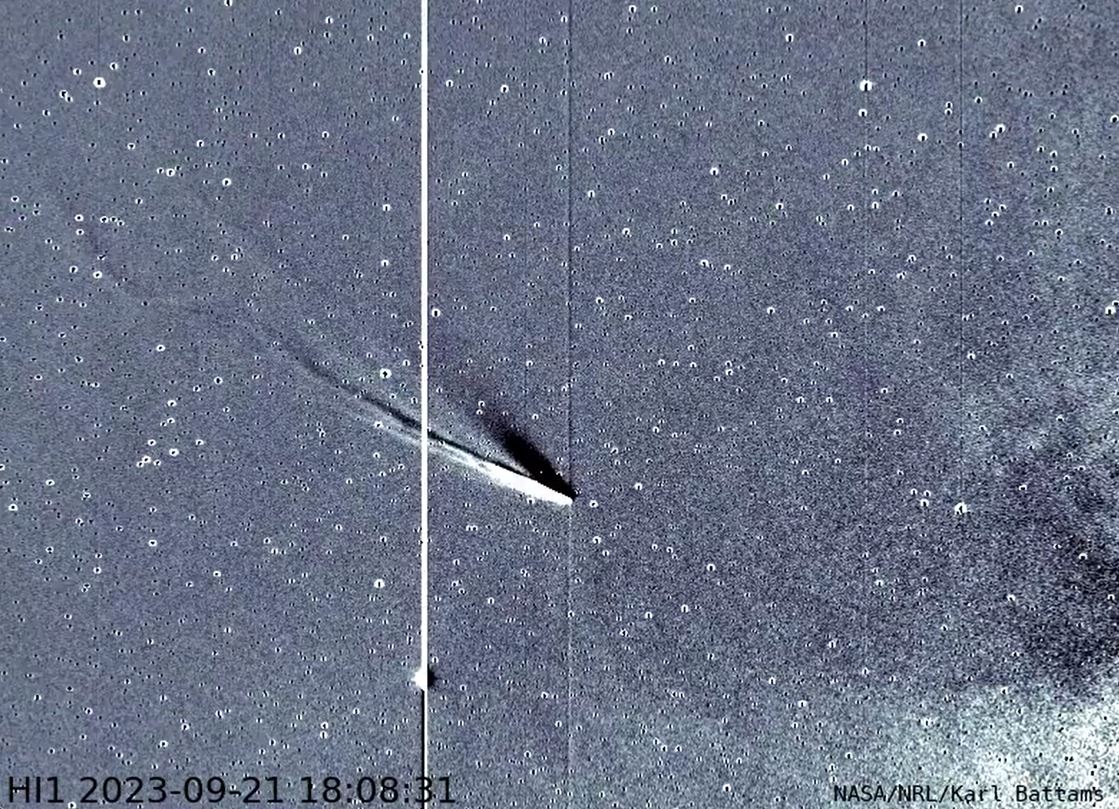
Courtesy of STEREO/SECCHI consortium
Movie of C/2023 Nishimura in STEREO HI-1 Sep. 17 to 23, 2023
https://stereo.gsfc.nasa.gov/img/stereoimages/movies/Nishimura_hi1_Sep17-23.mp4
https://stereo.gsfc.nasa.gov/gallery/item.shtml?id=selects&iid=238
Sep. 17 to 26, 2023
https://twitter.com/SungrazerComets/status/1707472701818830995
Nick James, Comet Section BAA Sep. 21, 2023
https://britastro.org/observations/observation.php?id=20230924_132628_0f77c27f27ce6827
When a bright comet like this enters a field of view of solar observation
satellites, variations in tails caused by the interaction between the
comet and the solar wind are clearly visible. It is really dynamic and
enhances to observe comets. I expect the appearance of great comet.
Monday, August 14
Monday, 14
I had overlooked C/2023 P1 Nishimura!
It was the peak of shower for Perseid yesterday and today. It had been
nasty weather in August followed July, but finally, we had clear sky this
predawn. I arrived at the observing site at 2:05am local time, and looked
up the sky for a couple of minutes. Unfortunately, I observed no meteors.
I was ready to sweep at 2:43am and tried to observe 103P Hartley 2 prior
to the comet hunting session. However, I gave up to do because I could not
spot the comet at a glance.
I start searching the sky with alpha Turi, Aldebaran, at 2:51am local
time. At 3:33am M1 came into the field of view (FOV). A small open
cluster, NGC2129 at 3:45am, two wonderful open clusters M35 and NGC2158 at
3:53am that inspired me. I observed many meteors of Perseids that I did
not before the comet hunting session, and high in the sky, zodiacal light
and the Milky Way merged. The imposing constellation, Orion, rose above
the Mt. Sobosan. The Eskimo Nebula (NGC 2392) was identified at 4:17am,
followed by M37 at 4:19am, and the last major object that came into the
FOV was thin moon at 4:36am. I was satisfied with the session.
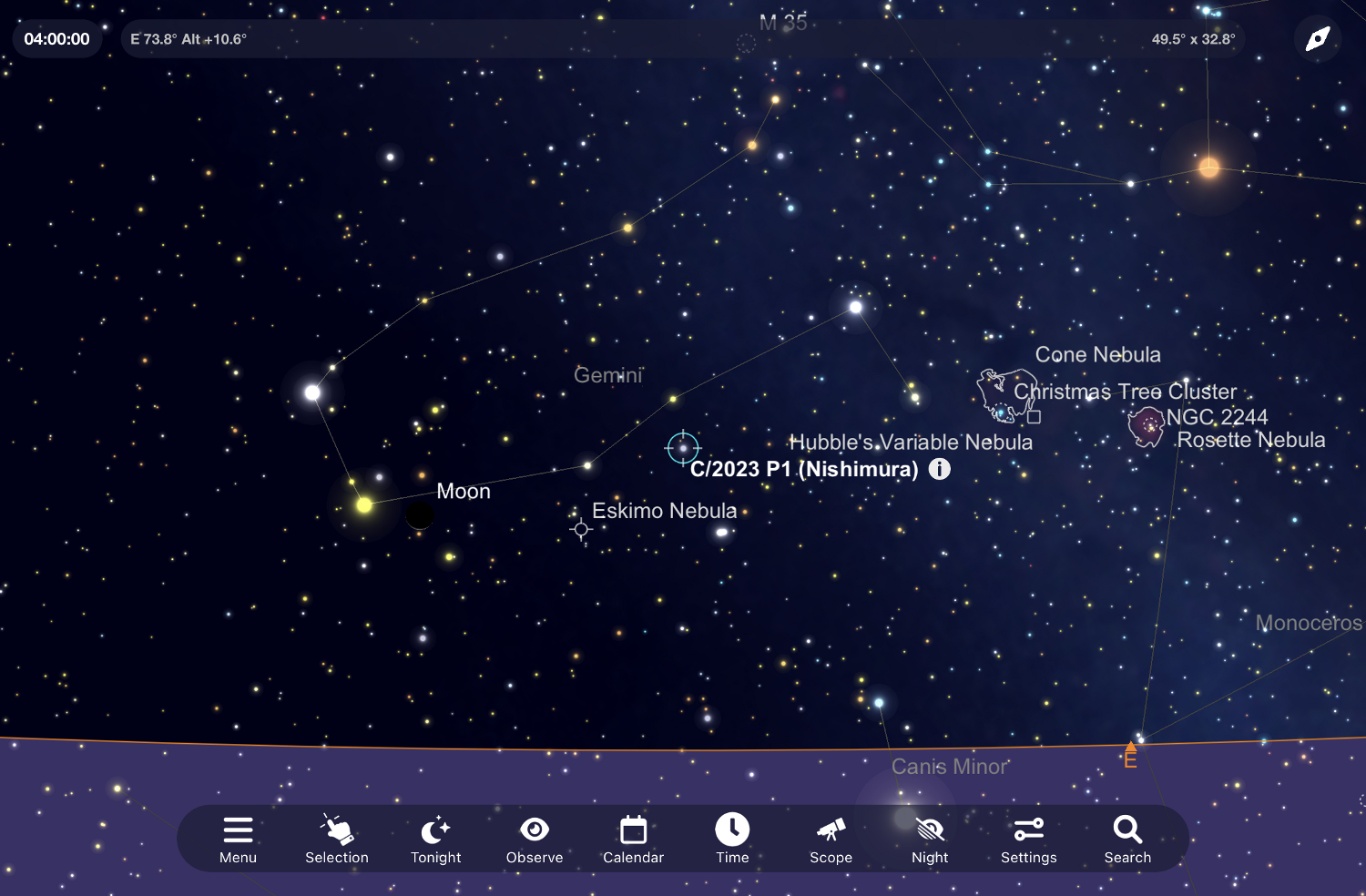
C/2023 P1 Nishimura. I identified the Eskimo Nebula at 4:17am local time,
and it was estimated that the comet had passed the field of view at around
4am local time. The diameter of the field circle is 1.1º. SkySafar7 Pro.
At the night when I got home after the job, I received an email in the
mailing list, comets-ml. The email said a bright comet was on the PCCP
(Possible Comets Confirmation Page, https://cgi.minorplanetcenter.net/iau/NEO/pccp_tabular.html).
The object was 10th magnitude and the position was some 5º east of the
Eskimo Nebula. I was sure to have searched the area, but why did I
overlook? The altitude above the horizon was 10º and the object would have
passed the FOV at around 4am. The beginning of the twilight was 4:08am
local time and the sky was dark enough.
The time stamp of the mail was 2:04am that was 1 minute before I arrived
at the site. Namely, if I had discovered the comet, I could not have
become a discoverer. It was too late.
The cause that I failed to overlook the comet was either 1) the comet was
invisible using NV or 2) it was visible using NV but I overlooked. It was
unlikely the case 2) as the overlapping of the FOV was sufficient and the
case 1) is likely. I need to wait for the next night of clear sky and
confirm.
Tuesday, 22
Finally, we had the second clear sky in August at the predawn. Having said
so, the site was basically foggy or overcast. I could search the sky only
20 minutes after the beginning of the twilight.
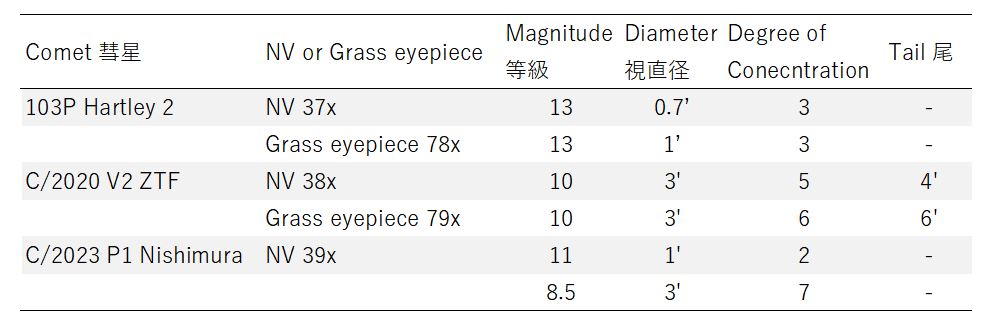
While the fog disappeared or through between the gaps of clouds, I
observed three comets. As shown in the table, only C/2023 P1 was extremely
dark using NV in comparison with the grass eyepiece (GE). It was
challenging to discover 103P as the image was faint but the difference in
appearance between NV and GE was slight. C/2020 V2 looked better with NV
than with GE.
Two comets discovered by Iwamoto (C/2018 Y1 and C/2020 A2) were difficult
to see or looked starlike (YouTube), and C/2023 P1 was the same.
Statistically, the number of comets that looked better using NV is more
than those using GE. Nonetheless, continuous discoveries of comets that
was difficult to see using NV made me reconsider the way of NV use. I
think I use NV only when under the moonlight or poor transparency.
Monday, July 17 (National holiday) and
Thursday, July 26
Monday, July 17
I went to the observing site on the previous day, Sunday July 16, but it
was cloudy and later turned foggy. Even so, I set up my telescope and
waited for clear sky until the start of the twilight. It did not clear up
and I took down the telescope after all.
It was foggy when I arrived at the site this day also. At the time when I
set up my telescope, there appeared slight gaps of clouds and I observed
C/2023 E1 ATLAS. I estimated the comet by intuition as 11th magnitude, 5’
in apparent diameter and DC=3 using Night Vision (NV) while 10th
magnitude, 3’ and DC=5 using a glass eyepiece.
This was the comet hunting session in about a month since June 19, and
there were a lot of clouds with fast motion. I trained the telescope at
cloud gaps and swept here and there. The deep sky objects identified were
NGC6340, a 11th magnitude galaxy in Draco, and NGC1502, an open cluster in
Camelopardalis that was as wonderful as a single flower blooming in the
field.
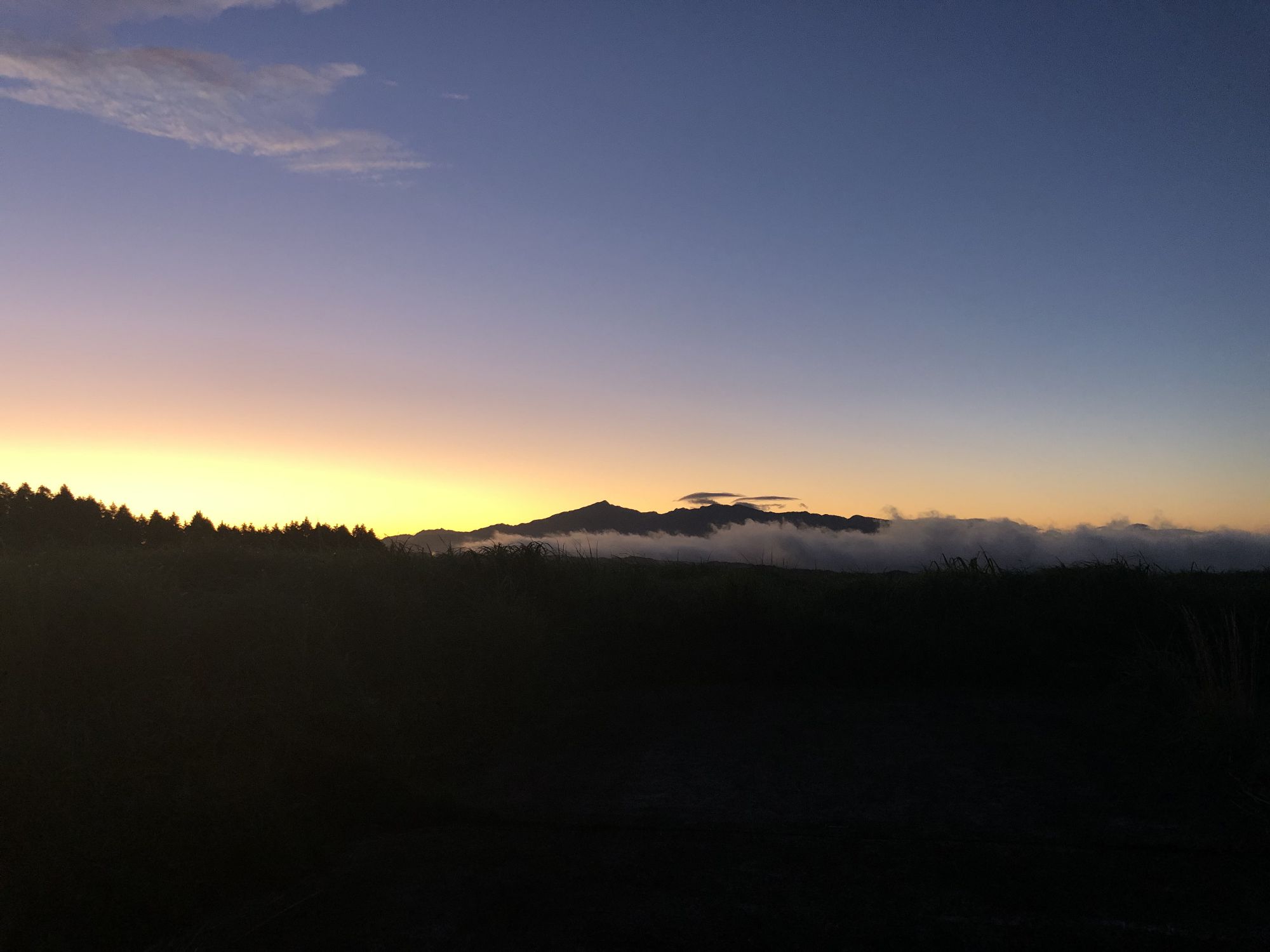
Mt. Sobosan. Clouds at the base of the mountain was fog that covered the
observing site not long ago. Video
The sky was clear only last 50 minutes out of one hour and twenty minutes
of total sweeping time. At the beginning of the twilight, Mt. Sobosan, a
mountain of faith, appeared with good air transparency. The morning glow
was beautiful, and soon a Tanna japonensis began to sing. Bird song
followed (see video). It
was indeed a refreshing morning.
Thursday, July 26
It was foggy up on arriving the observing site. Soon after setting up the
telescope, I aimed it at 12P Pons-Brooks that was in a big outburst. The
comet looked the same both using NV and a glass eyepiece: 11th magnitude,
1’ and DC=7. The comet appeared to be slightly smaller version of NGC4361,
a planetary nebula in the Corvus. I had information that the comet has a
continuous spectrum, and as expected there was no difference in appearance
between NV and the glass eyepiece.
On the contrary, there was a difference in appearance between eyepieces
for C/2020 V2 ZTF. The comet was 11th magnitude, 3’ and DC=3 using NV
while 10th, 4’ and DC=4 using the glass eyepiece.
After observing two comets, I waited for clouds to disappear. At 2:43am
local time, I began to search from M45 because clouds disappeared. Eight
minutes later, clouds covered the area and interrupted. After 10 minutes,
resumed but interrupted in 8 minutes, and 17 minutes later resumed again.
The weather changed rapidly and I was unsettled. I detected no deep sky
objects, and could not see Mt. Sobosan and morning glow.
We have potential to discover comets visually like 12P Pons-Brooks that
makes a outburst. Comets behave in an unexpected way.
Thursday, June 22
I gave a presentation entitled “Visual comet hunting using Night
Vision” at the Annual Comet Conference in Kurashiki that was held on
Saturday, 3 June and Sunday, 4 June.
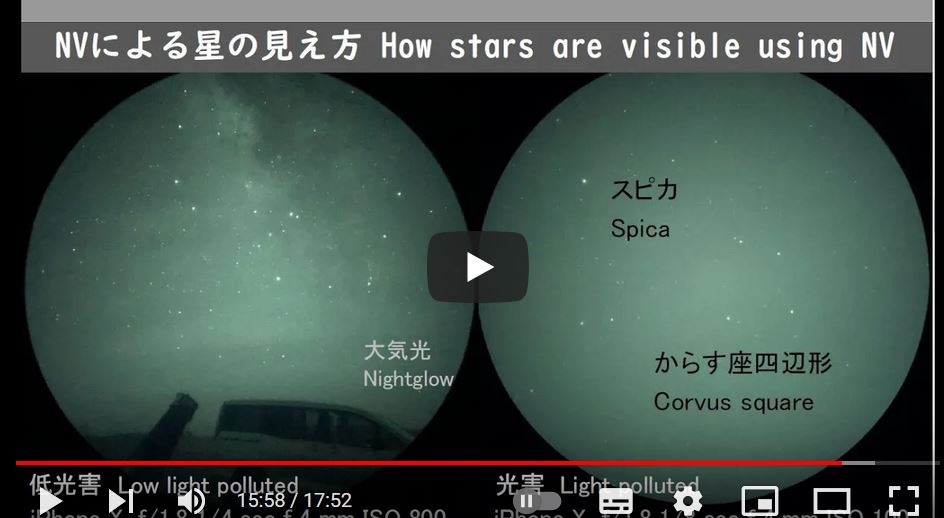
YouTube Visual
comet hunting using Night Vision
Presentation
file
Related article
The links above are presentation movie with the file. The content was a
comparison of comet visibility between conventional glass eyepieces (GEs)
and Night Vison (NV) that I have used for some four and a half years. To
make the result simplify, NV is more advantageous for comet discovery than
GE, as I often mentioned on the present web page.
C/2018 Machholz–Fujikawa–Iwamoto was the last comet that discovered
visually. I gave a presentation with the hope that the application of NV
can promote additional visual comet discovery. I have contacted a comet
discoverer recently, and he said he was ready to start visual comet
hunting using NV that he purchased lately referring to my web page. I was
glad to hear that and it made me courageous.
The Annual Comet Conference had not been held two consecutive years due to
Covid-19. Last year it was held online, and as a result the conference was
held face-to-face in 4 years. The number of attendees at the venue was 36
and online was 17, i.e. 53 in total. Nearly half of the attendees arrived
at the venue some 5 hours late on the first day of the conference, because
Tokaido Bullet train was out of service in the morning due to heavy rain.
Still, perhaps because it had been a long time since the event was held
last, it was more fulfilling than ever.
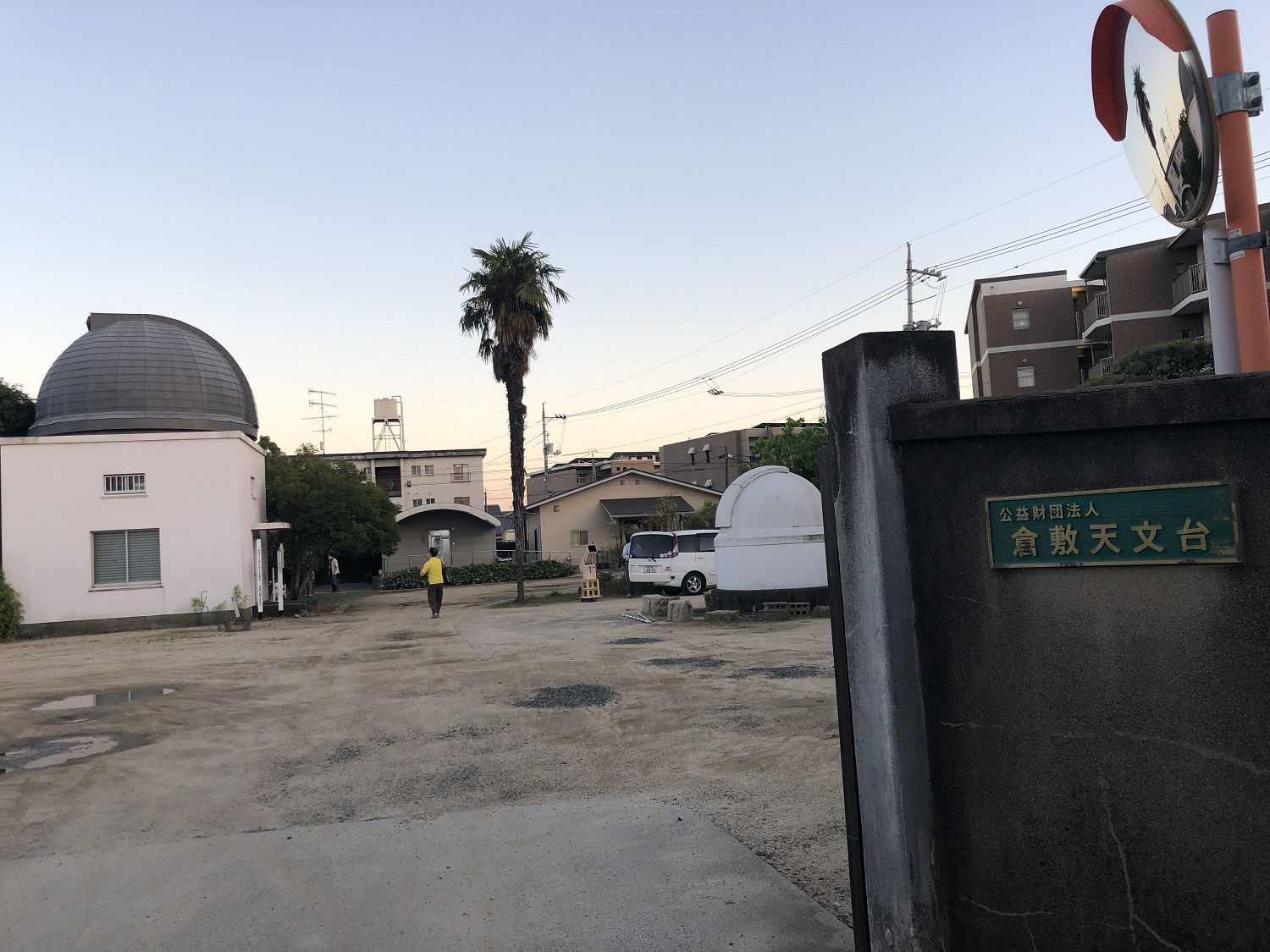
Kurashiki Observatory where Minoru Honda worked.

The sliding roof of former Kurashiki Observatory built in 1926.
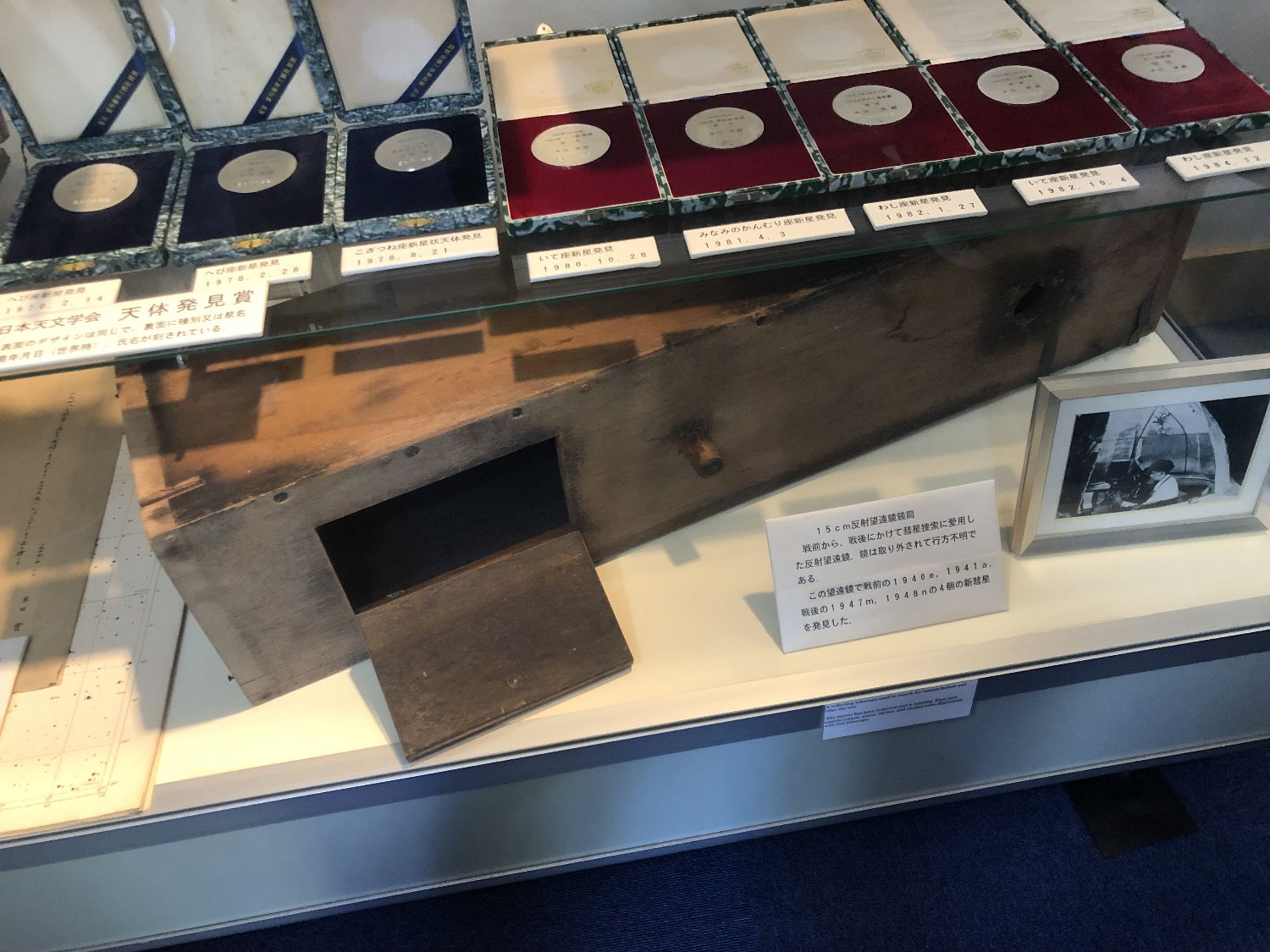
Homemade 15 cm reflector that Minoru Honda used and medals for discovery.
Honda discovered 4 comets using the 15 cm telescope.
The venue of the conference, Kurashiki, Okayama Prefecture, is the place
that Minoru Honda, “God of comets”, worked. At the same time Okayama is
the place where many of the largest class telescopes are located in Japan.
It was regrettable that I could not spend enough time to see his
footprints due to lack of time.
In the afternoon on Sunday, I attended the excursion that visited, SEIMEI
telescope, the largest telescope in Japan. There is the 188 cm telescope
in the adjacent to SEIMEI telescope. When I attended the Annual Comet
Conference in 1977 for the first time (the venue was Kobe), I visited the
188 cm telescope as an attendee of the excursion. Fort-six years have
passed since then and I have discovered two comets. I was deeply impressed
to stand the same place.
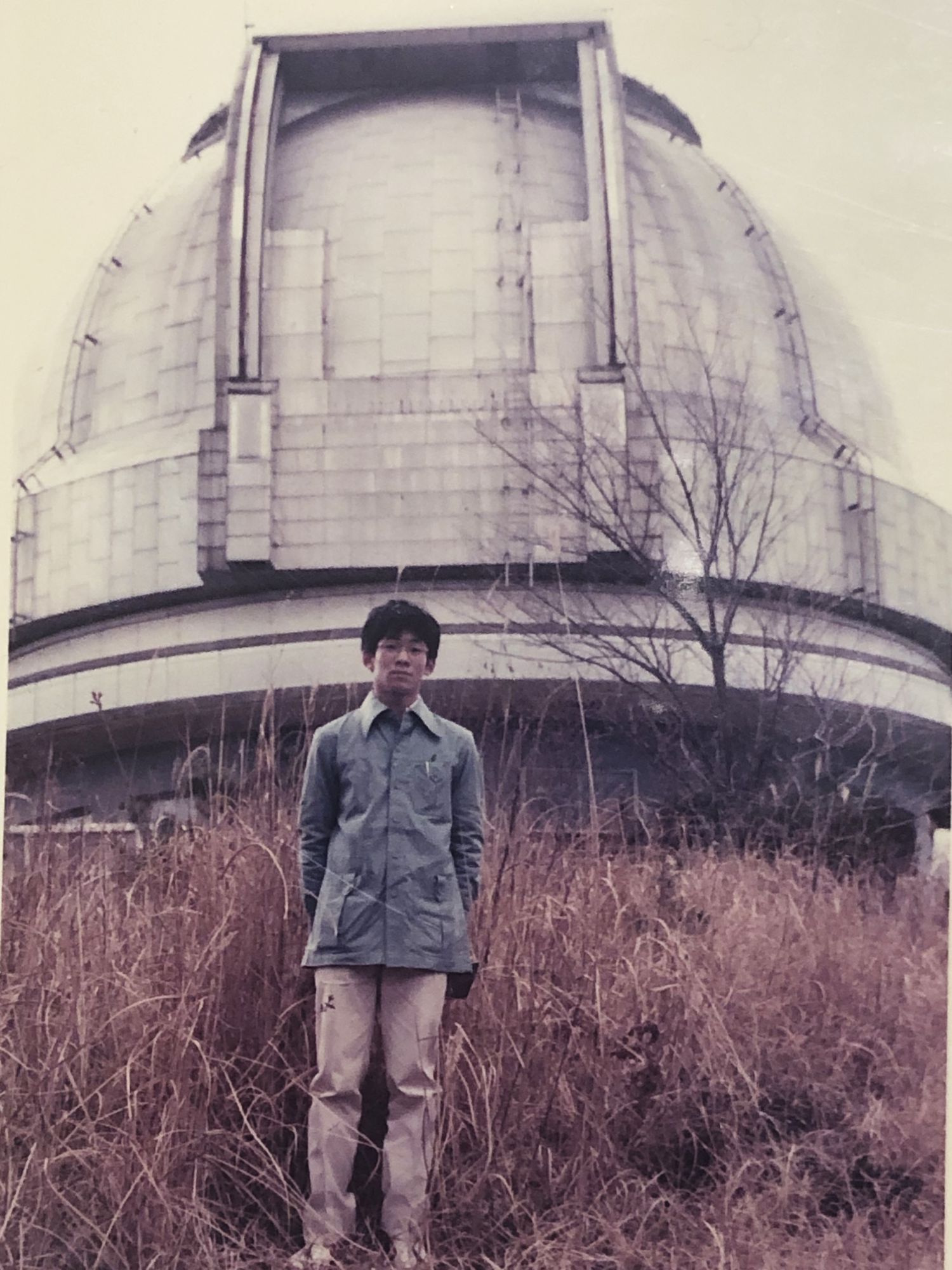
I was standing in front of the 188 m telescope dome in 1977. I fearfully
asked Minoru Honda who was walking nearby and asked him to take this
photo.
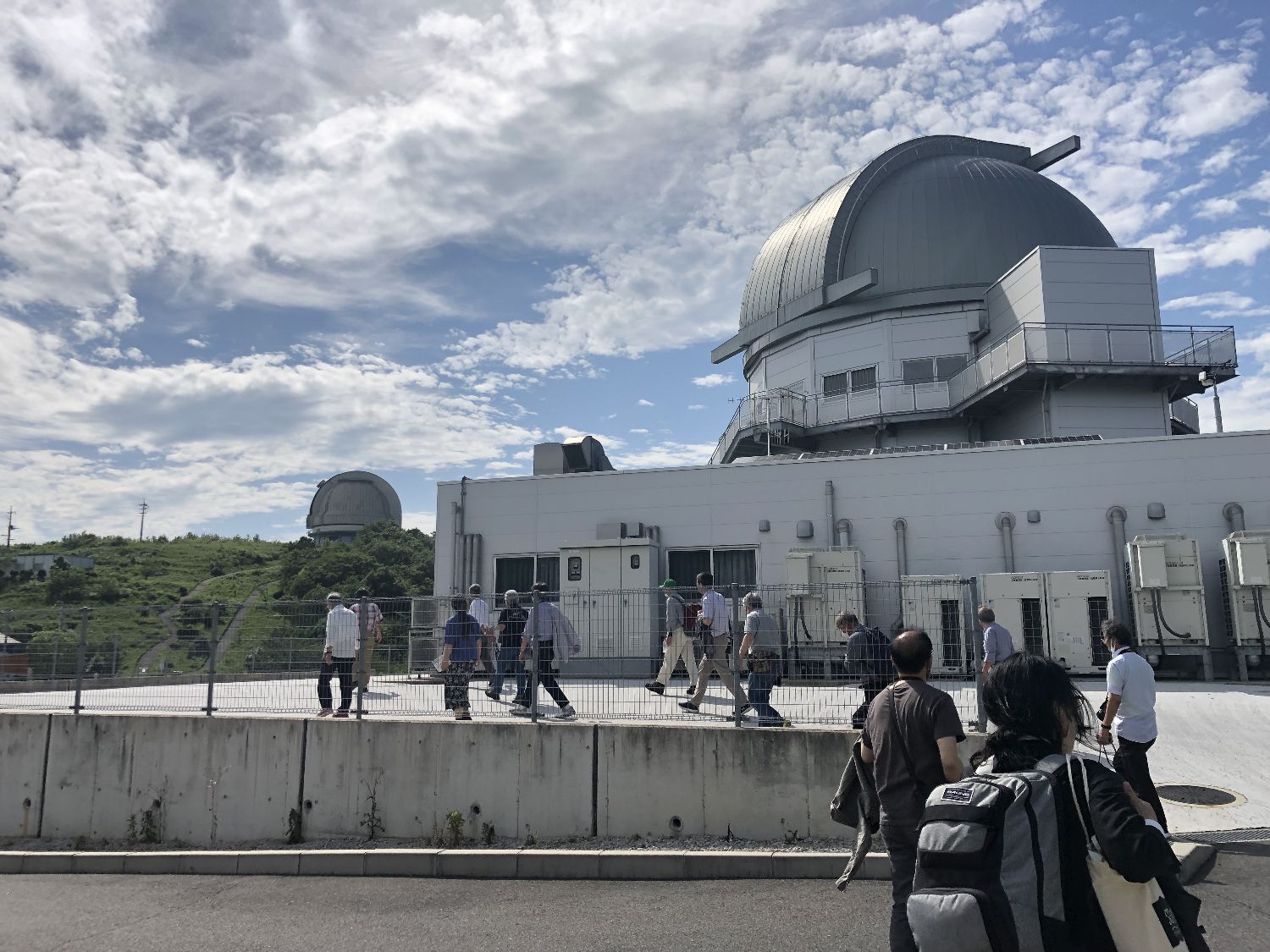
SEIMEI telescope 3.8 m (front) and the 188 cm telescope (background)
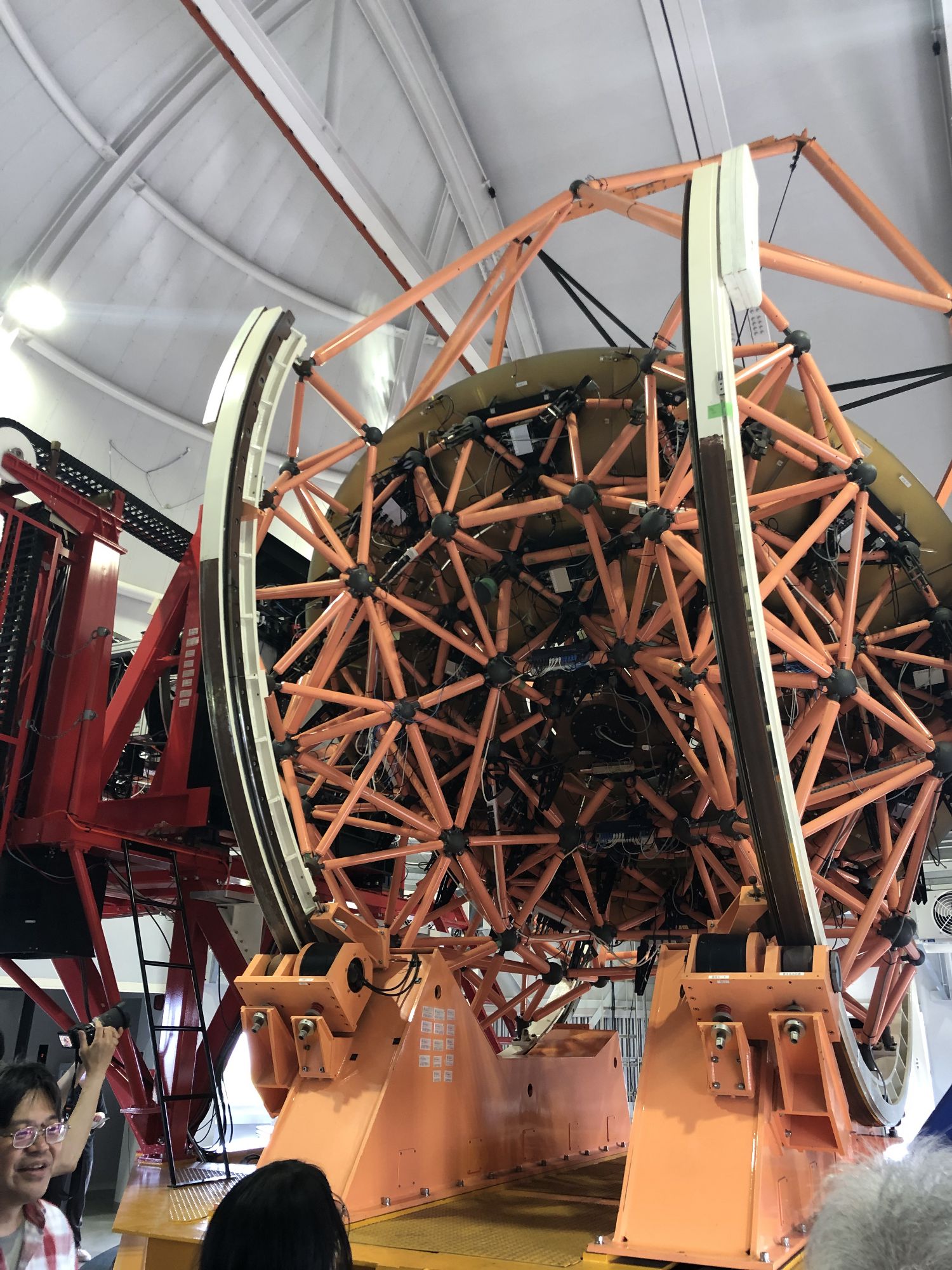
The rear of the primary mirror for SEIMEI telescope
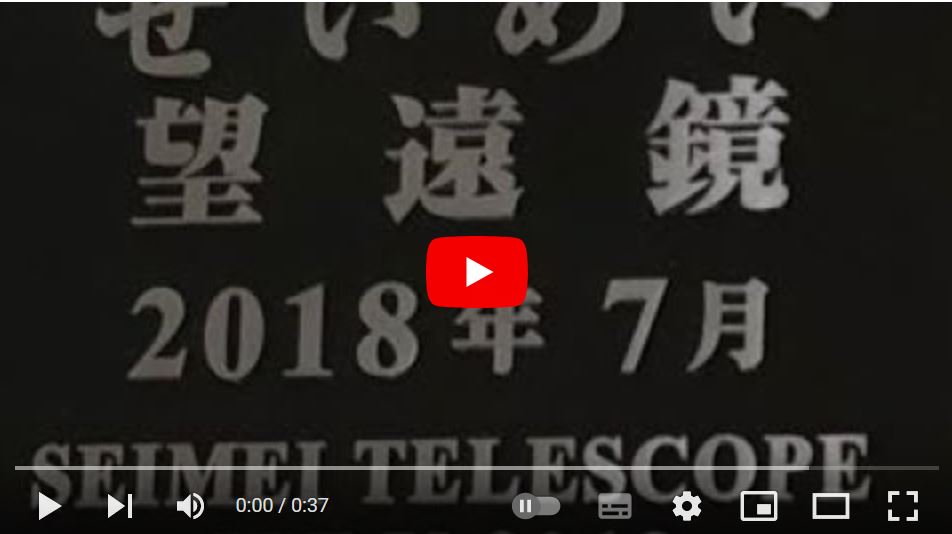
SEIMEI Telescope, 3.8 meter, (Kyoto
University Astronomical Observatory) moves rapidly (movie).
This year’s conference was the second most impressive one following in the
one that I attended for the first time in 1977.
Wednesday, May 24
The fourth comet hunting session in May. My back ache got better and I
could set up my 46 cm comet seeker. Prior to the searching session, I took
photos on the observing site seen using Night Vision (NV). The photo is
used in the presentation on NV at the 51st Annual Comet Conference in
Kurashiki that will be held on Saturday, June 3 through Sunday, 4 June.

Observing site viewed through Night Vision
iPhone X f/1.8 1/4 sec f 4 mm ISO 800
The tail of Scorpius is at the center of the photo, and an open cluster in
the same constellation, M7, is slightly above the center. Complicated
bands in the Milky Way that are not seen with naked eyes are clearly
viewed. Clouds like image that extends horizontally is not clouds but
nightglow. Actual image was much finer and smoother; however, it was not
reproduced well photos taken using a smart phone.
After taking photos, I started the comet hunting session with Saturn
located in the constellation of Aquarius at 2:30am local time. I felt
unsatisfied with the search around the area, because there are no
conspicuous deep sky objects there. Finally, I identified 10th magnitude
galaxy, NGC7606, in Aquarius at 3:13am at rather low altitude of 16º.
Three minutes later, NGC7391, 12th magnitude galaxy with the diameter of
1.5’ came into the field of view. Five minutes after the beginning the
twilight, I identified two galaxies, NGC7541 (11th mag.) and 7531 (13th
mag.). I noticed NGC7531when I confirmed NGC7541 using SkySafari 7 Pro and
looked into the field of view again. Eleven minutes after the beginning of
the twilight, I noticed NGC157, the 10th magnitude galaxy in the
constellation of Cetus, at the altitude of 8º. The image of NGC157 was
faint and I think it was not visible using a conventional glass eyepiece
(GE). NV is powerful during the twilight.
I will give a presentation entitled “Visual comet hunting using Night
Vision” at the Annual Comet Conference next month. I will show you a part
of the presentation.
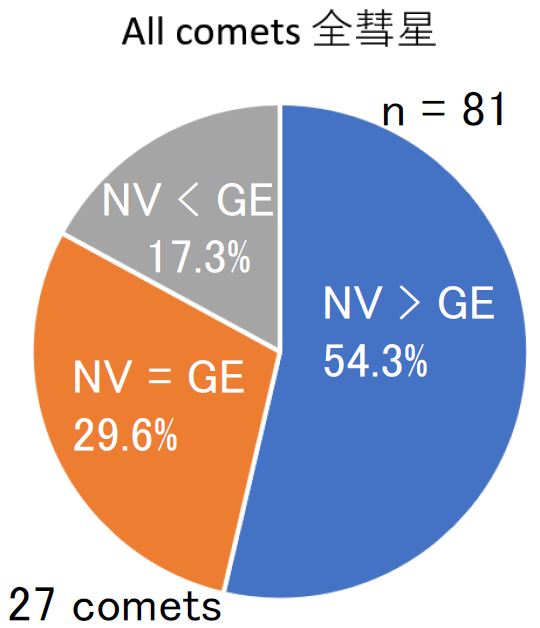
Comparison of comet visibility between Night Vision (NV) and conventional
glass eyepieces (GE). NV > GE: NV is more visible than GE, NV = GE:
equal visibility in NV and GE, NV < GE: GE is more visible than NV.
I compered 27 comets in total with 81 times of observation. NV was more
visible than GE for over half of comet observations. Contrary, comets that
were easier to observe with GE than with NV were less than 20%.
A video of the presentation will be made available at a later date.
Thursday, April 27
The third comet hunting session in April. I also went to comet search
on Sunday, April 23, however, I was forced to return to my home after
enjoying star gazing by naked eyes for a while without setting up my 46 cm
telescope at the site. The reason was my back ache that I have been
suffering since last month.
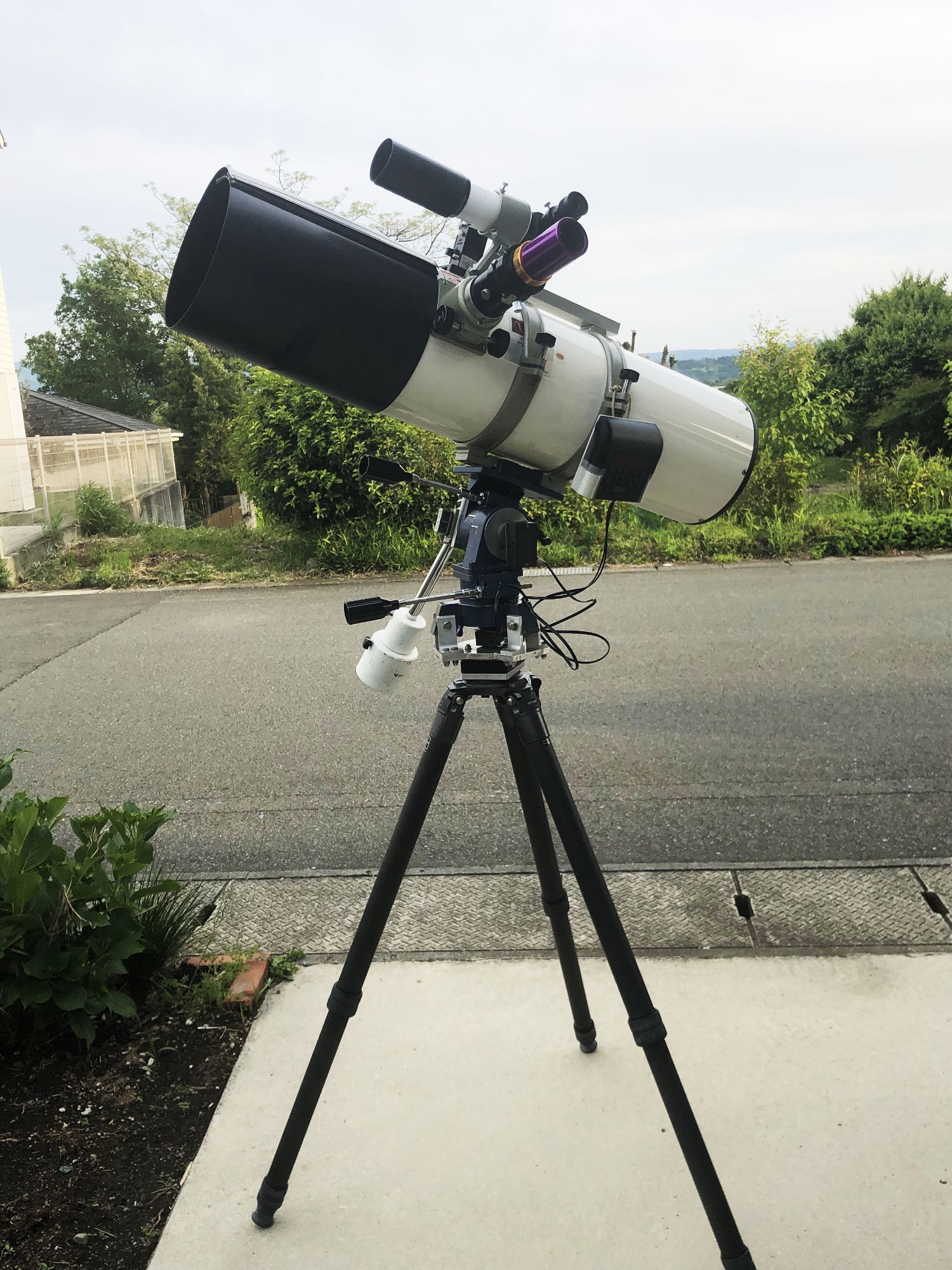
Twenty-cm reflector equipped with Nexus DSC. Night Vision is not set in
front of the eyepiece in this photo.
I utilized my 20 cm telescope this time, and I had no trouble to setting
it up and could conduct the hunting session in spite of my back pain. When
I employ my 46 cm scope, 37x with the field of view (FOV) of 1.1º by
combining Lavendura 63 mm, Paracorr, and Night Vision (NV). In case of my
20 cm reflector, 15x with the FOV of 2.7º using the same combination that
has by far the widest of view but less light gathering power.
Before the start of the hunting session, at 3:10am local time I tried
training the 20 cm on C/2022 A2 PanSTARRS, a 11th magnitude comet. I could
not spot it at a glance as the altitude being only 8º above the horizon.
It is easy to observe the comet with my 46 cm even if it is located at
such a low altitude.
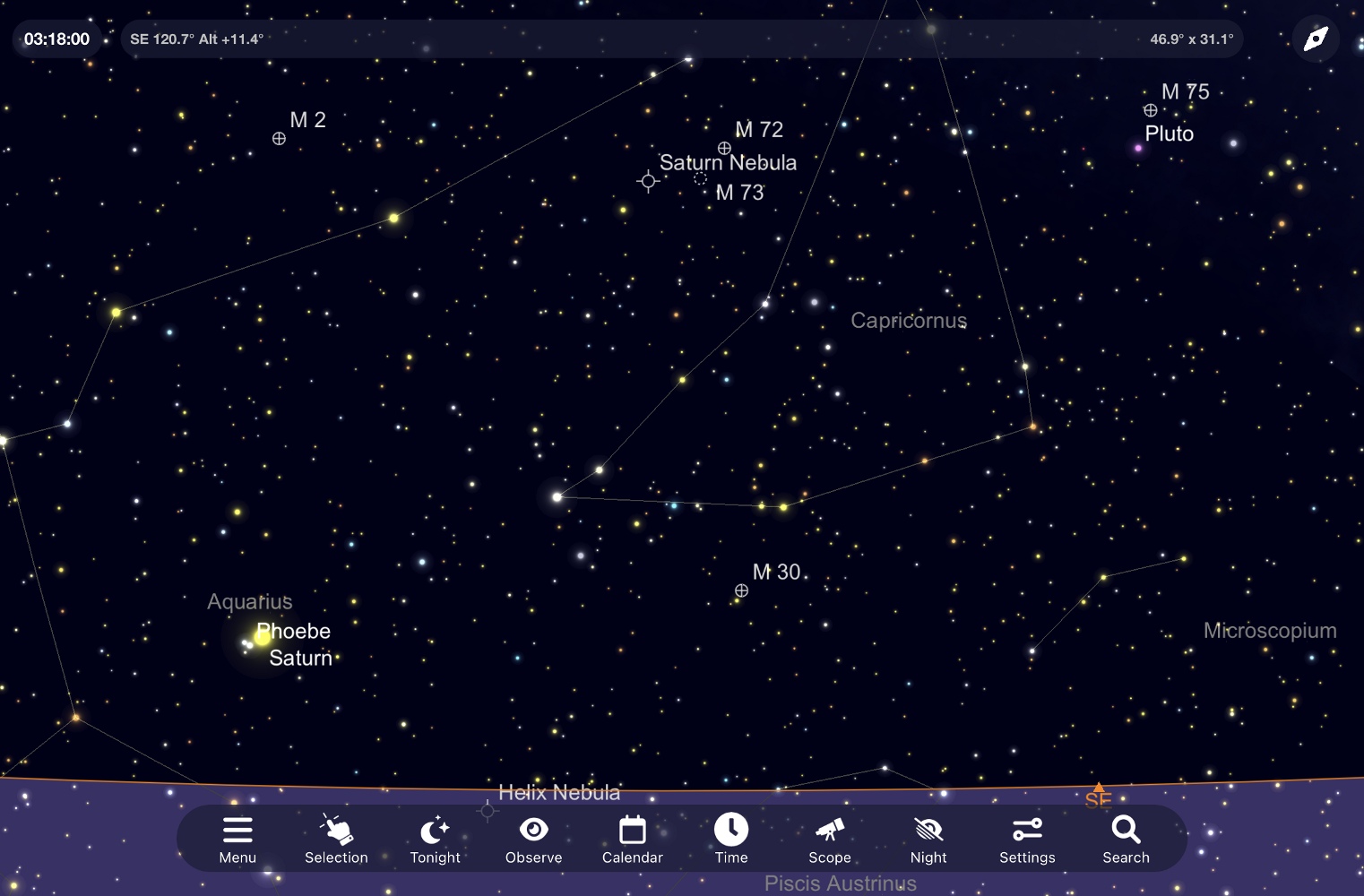
Coincidentally, at the start of the hunting session three globular
clusters, M75, N72 and M2, were located at the altitude of approximately
20º above the horizon. Screen shot from SkySafari 7 Pro.
At 3:18am local time, I began to sweep the sky from M75, a globular
cluster in Sagittarius. I move the telescope vertically when I use my 46cm
to sweep the sky, but this time I swept horizontally with my 20 cm. Soon
after the start of the session M2, a globular cluster in Aquarius,
followed by M72, also a globular one in the same constellation, passed
through the FOV. I observed those clusters within one minute. All of them
were at the altitude of around 20º at that time.
After observing those objects, M30 in Capricornus and Saturn came into the
FOV. At 4:02am local time, just before the beginning of the twilight, I
aimed my telescope at C/2022 A2 again. Although the altitude of the comet
was as high as 17º, I could not notice the object at first glance. I
confirmed the position using SkySafari 7 Pro, and I finally detected the
comet with faint image that was somehow visible. Replacing NV with Ethos
21mm, the image was still faint and hard to find.
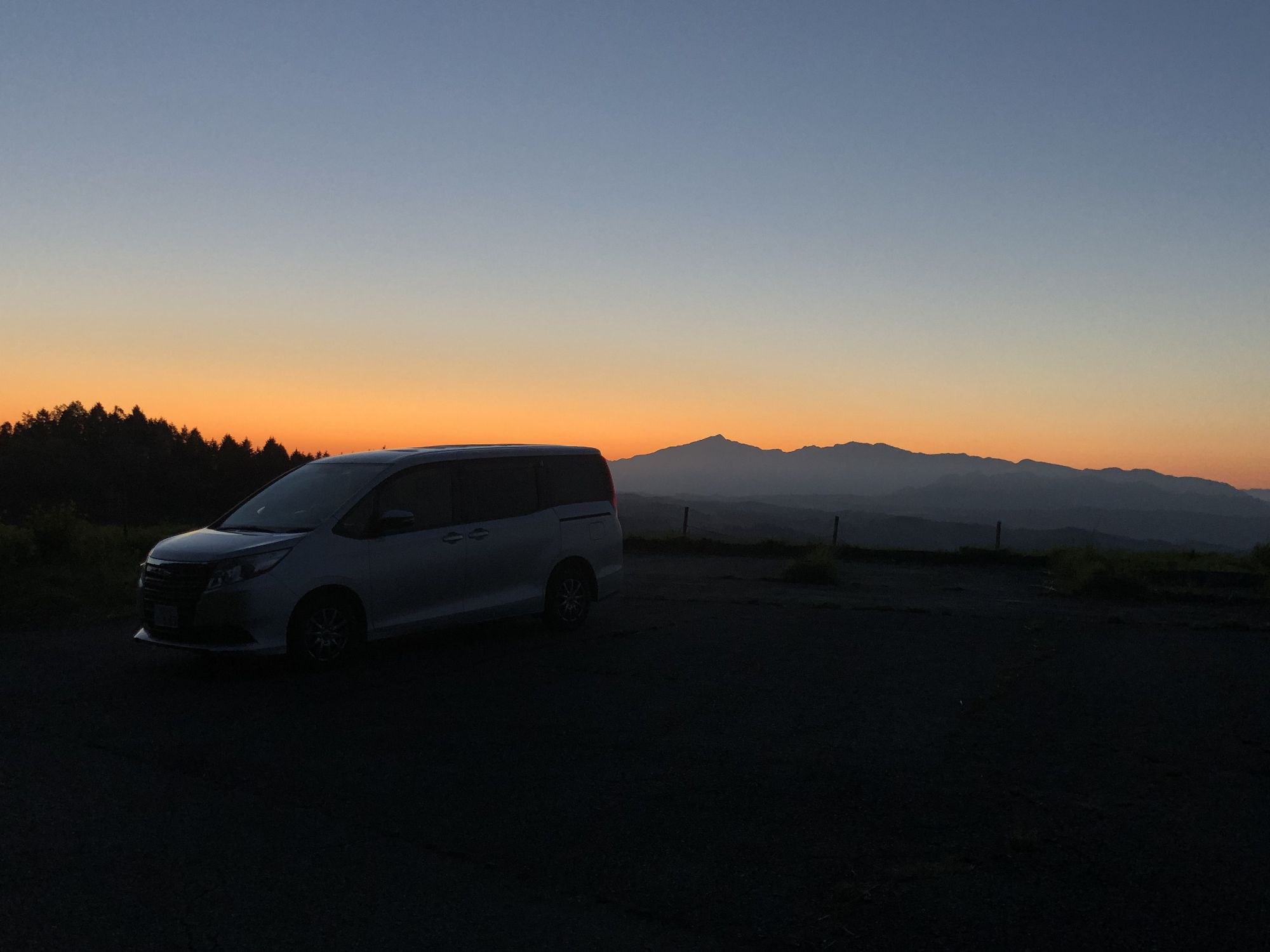
Mt. Sobosan in red morning
I ended the hunting session at 4:30am and enjoyed observing M22, M8 and
M20. Even though it was during twilight, it was impressive that countless
number of stars in the Milky Way filled with the FOV of 20 cm, 15x and
2.7º. When I started taking down my telescope Mt. Sobosan appeared
silhouetted against the beautiful morning glow.
Sunday, March 19
The fourth comet hunting session in March. Moon rise was 4:54am local
time that was six minutes before the start of the twilight, and
substantially, it was dark night. The temperature gradually declined from
3ºC to 0ºC, but I felt chilly due to wind.
I began sweeping the sky with M22, a globular cluster in the constellation
of Sagittarius, which is wonderful and worth observing one like M13 and
M5. There are a small number of deep sky objects in the east of M22 in the
horizontal coordinates at this time. I identified only four of them during
the session: M17, M55, NGC6712 and M75. M55 came into the field of view at
the altitude of only 7º above the horizon, however, the cluster was
brilliant being resolved into stars thanks to the power of Night Vision
and the 46 cm telescope.
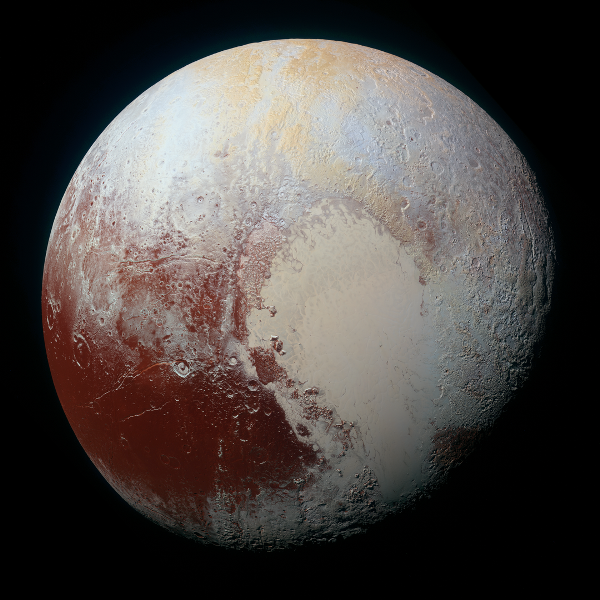
Image of Pluto taken by New Horizons.
https://commons.wikimedia.org/wiki/File:Pluto-01_Stern_03_Pluto_Color_TXT.jpg
I must say the today’s highlight was Pluto. Pluto was indicated only 58’
southeast of M75 when I confirmed the globular cluster using the digital
map, SkySsafari7 Pro! I thought Pluto could be visible because I employed
Night Vison in spite of the magnitude of 14.5 with the altitude of only
14º. Although I compared the array of stars in the field of view with the
map, I could not spot it with ease because I did not prepare in advance.
In addition to that, as the stars were at the low altitude and those with
14th magnitude and darker were sometimes hidden and disappeared because of
scintillation that made it challenging to observe the object. After five
minutes of persistence, I could finally identify Pluto. I think more than
ten years have passed since I observed Pluto last.
In my boyhood, I expected I would never see Pluto by my eyes throughout my
life. To observe the object, a telescope with the aperture of 30 cm or
more is needed. At that time, there were only a few of them in Japan.
There was no prospect to be able to use such a telescope even as an adult,
not to mention owing it by myself. Unexpectedly, the price of a telescope
with the aperture of 30 cm class has dropped to within easy reach of most
people before we know it. It was over 20 years ago when I saw Pluto for
the first time. In recent years, studies on Trans-Neptunian region have
progressed and Pluto has demoted from planet to quasi-planet in 2006.
Pluto has become one of the Trans-Neptune objects, and it is believed that
its content is the same with that of comets. How interesting! When I saw
Pluto, which looked just a “dot” and like the same as many stars in the
same field of view, an endless story unfolded in my mind that started from
the discovery of this object by Clyde William Tombaugh in 1930. Stars are
seen with the mind.
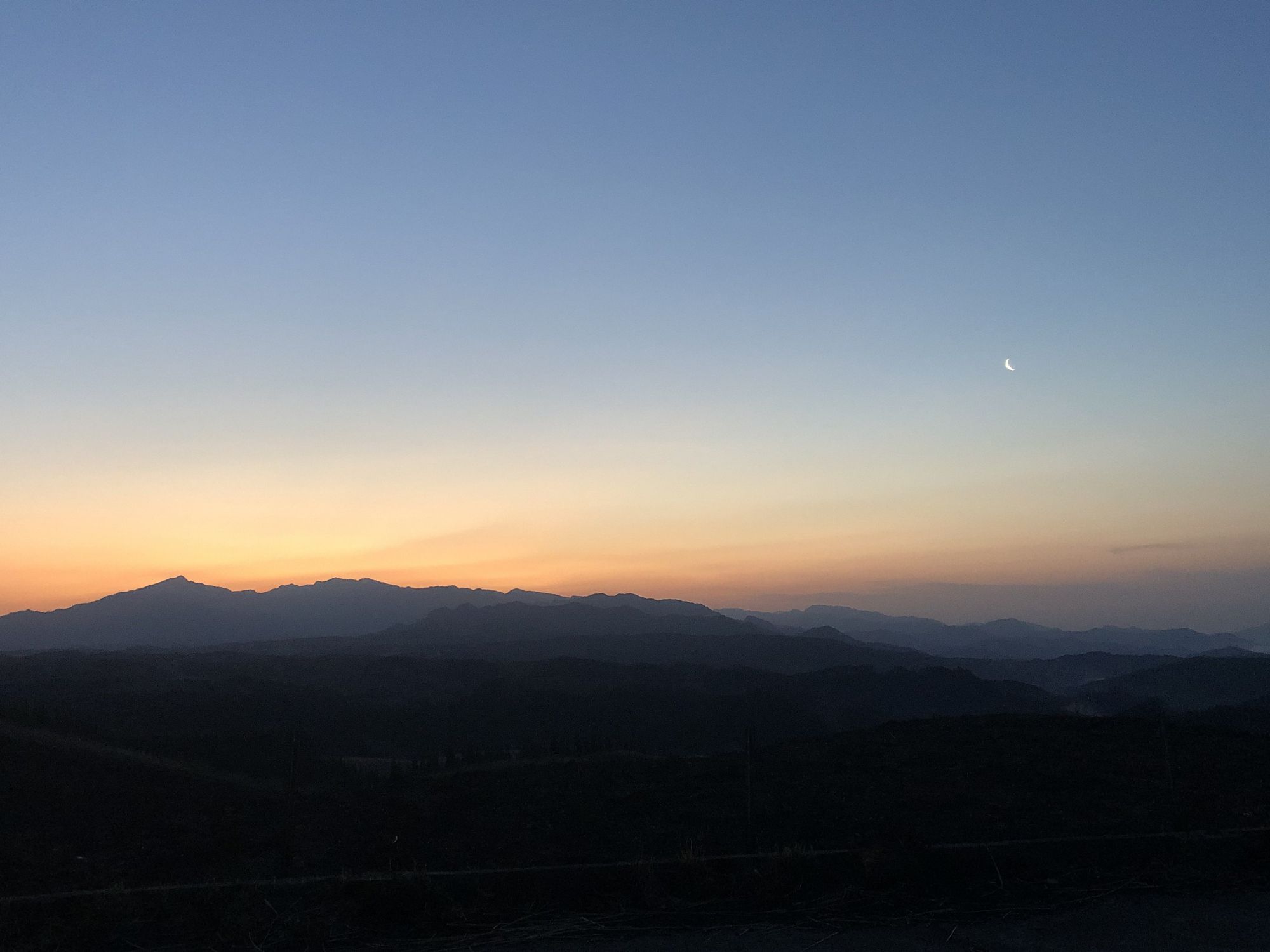
Mt. Sobosan in the morning glow (right) and the moon (left).
Th thin moon rose almost the same time with the beginning of the twilight.
When I finished the comet hunting session, a sea of clouds began to spread
beyond the mountain range and Mt. Sobosan, the mountain of faith, was in
the morning glow.
Friday, February 17
Yesterday, it was bitterly cold with the air temperature of -6ºC and
strong wind, while today I felt it was very warm with the temperature of
-3ºC and windless condition. The moonlight was reduced, and the star image
was stunning pinpoint thanks to stable air.
I have observed two 13th-magnitude comets before the start of the comet
searching. Firstly, I tried to spot C/2019 U5 PanSTARRS using Nexus DSC
Pro and SkySafari 6 Pro. It took me a while to find the comet; for one
thing the alignment accuracy of the digital setting circles was slightly
poor with unknown cause, and I could not spot the comet right away when I
looked around the FOV because the comet was rather dark for another. I
estimated the object as 13th magnitude with the diameter of 1’ and DC = 3,
and I thought it was challenging to spot it during the comet hunting
session. I also spent some time to identify the next comet, C/2019 T4
ATLAS. It was observed as the magnitude of 13, the diameter of 0.3’ and DC
= 3. I also observed C/2019 T4 using the glass eyepiece, Ethos 21 mm +
Paracorr, but the visibility with NV was superior. While I was observing
those comets, I found the crescent moon shining softly in the
constellation of Sagittarius rose above the horizon.
Globular clusters with individualities
I began the comet hunting session with M19, a globular cluster in the
constellation of Ophiuchus, at 4:45am local time. Observing M19 with NV
was wonderful, countless stars were resolved into stars with pinpoint
image. Although the altitude of the object was only 19º above the horizon
at the time of observation, it was magnificent due to the power of NV.
Soon after I moved the telescope downward, NGC6284, a compact and slightly
sparse globular cluster, came into the FOV. Once the FOV reached the
horizon, I reset the telescope at the altitude of 30º and resumed to sweep
downward.
Then, I spotted NGC6235 that looked like a smaller version of M19, and
only 2º below it I identified NGC6284 that includes many stars in the area
far from the center of the cluster. The time interval for observing the
two globular clusters was only a few seconds. Additionally, beautiful
globular clusters entered the field of view one after another during the
session. Although all of them were at the low altitude, I enjoyed
observing 29 globular clusters, each with a unique face, in total.

M19 |
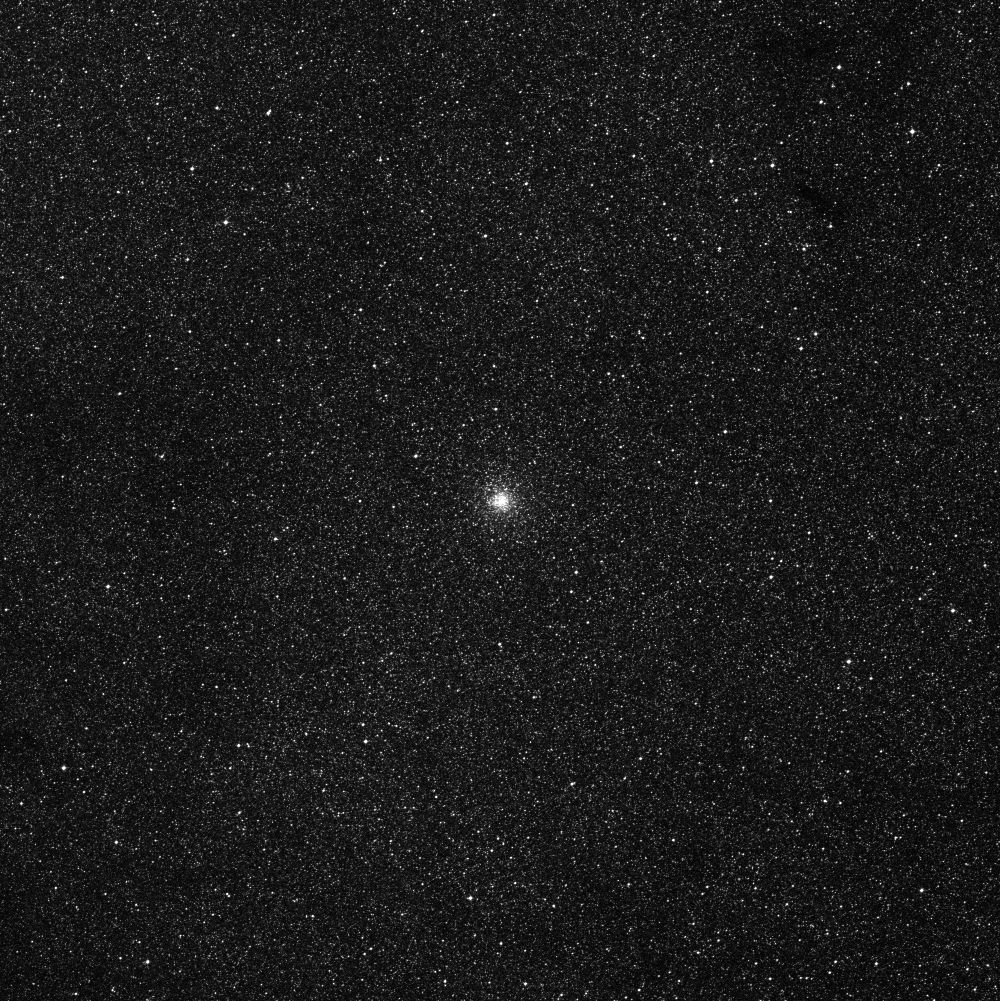
MGC6304 |
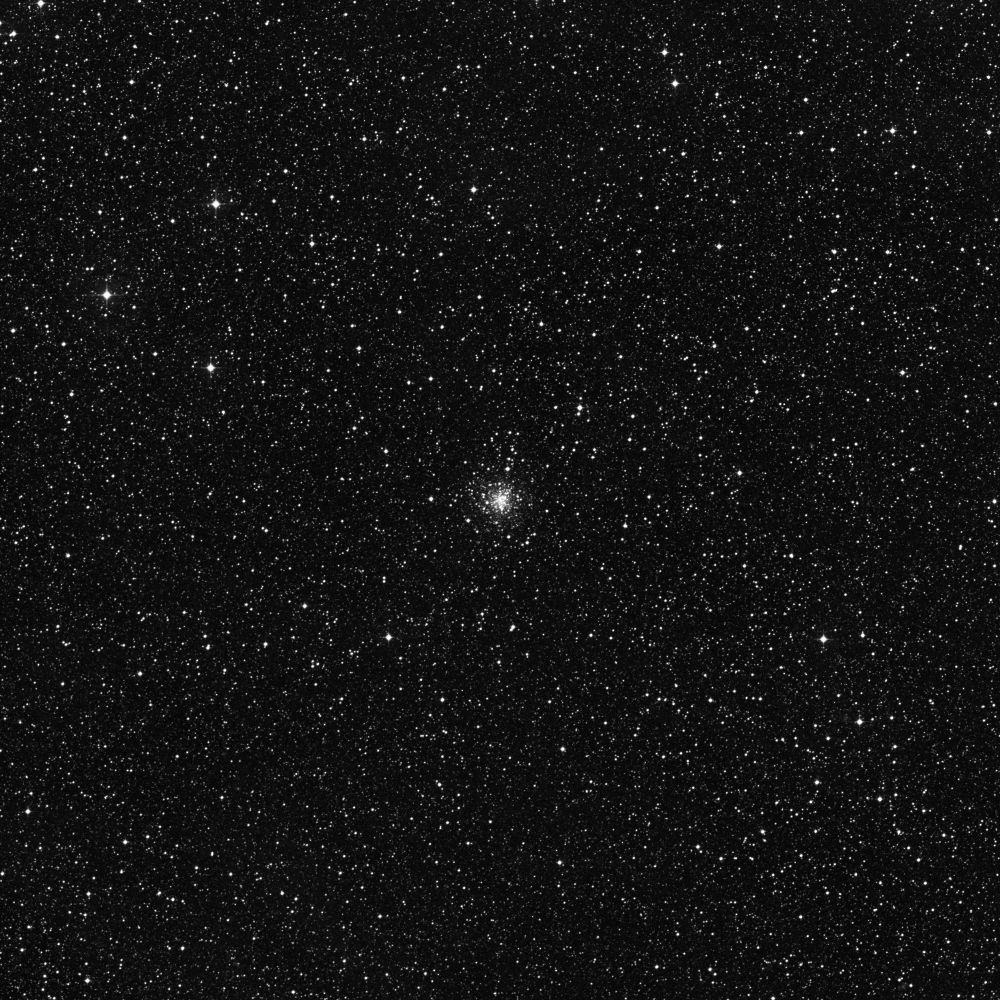
NGC6235 |

NGC6284 |
The images are 60’ in width.
The Digitized Sky Survey copyright © 1994
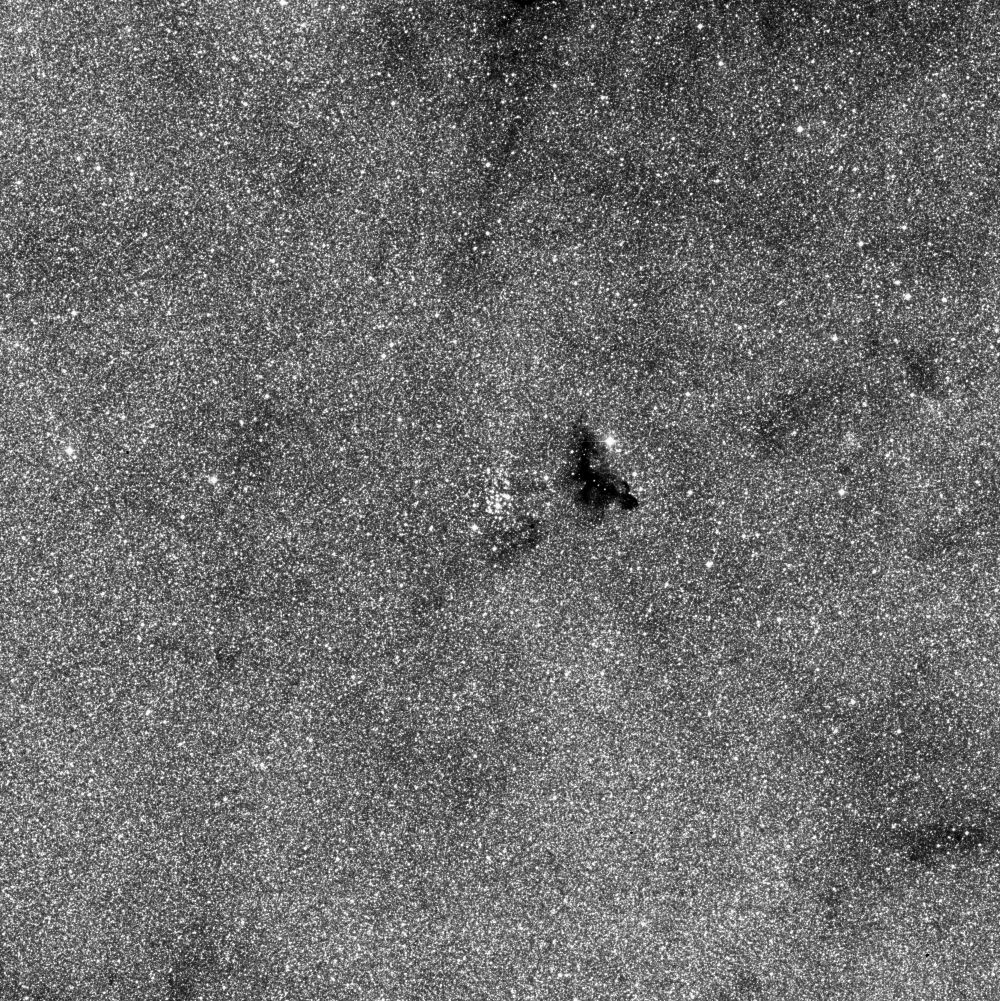
NGC6520 and dark nebula Barnard 86.
The image is 60’ in width.
The Digitized Sky Survey copyright © 1994
From my experience to date, there are three kinds of globular clusters:
firstly, observation using NV is the best, secondly, using a glass
eyepiece is, and both NV and a glass eyepiece are the same. For instance,
M13 and M22 are obviously more wonderful using a glass eyepiece than using
NV, while NGC5139 (Omega Centauri) is equally stunning with NV and a glass
eyepiece.
The deep sky objects other than globular clusters that recorded in the
observation memo were M6, M7, NGC6445 (a planetary nebula in Sagittarius
seen in the same FOV with a globular cluster NGC6440), and a pair of
NGC6520 (open cluster) and Barnard 86 (dark nebula). If I used a glass
eyepiece for observation of Barnard 86, the visibility of the object must
be poor because of the altitude of only 9º. Nevertheless, I was impressed
by the dark nebula with the aid of the high performance of NV. I must say
it was truly a sweeping session to enjoy the starry sky.
Saturday, January 21 to Sunday, January, 22
Saturday,
Drawing a sketch of C/2022 E3 ZTF
Although air temperature was as low as -6ºC, the condition was
favorable without wind and clear sky. C/2022 E3 brightened up to 6th
magnitude and worth observing. I have observed the lengths of the ion and
the dust tails of the comet as 1.5º and 0.5º, respectively, on Tuesday,
Jan. 17 using my 46 cm reflector, and I was curious about the present
situation of the tails. The appearance of the tails observed by Night
Vision, 37x was equivalent with that seen by Ethos 21 mm + Paracorr, 112x.
I confirmed the length of the dust tail was 0.5º using a 7x50 mm binocular
at this predawn after 4a.m. local time. I tried to detect the comet by
naked eye but could not do by any means.
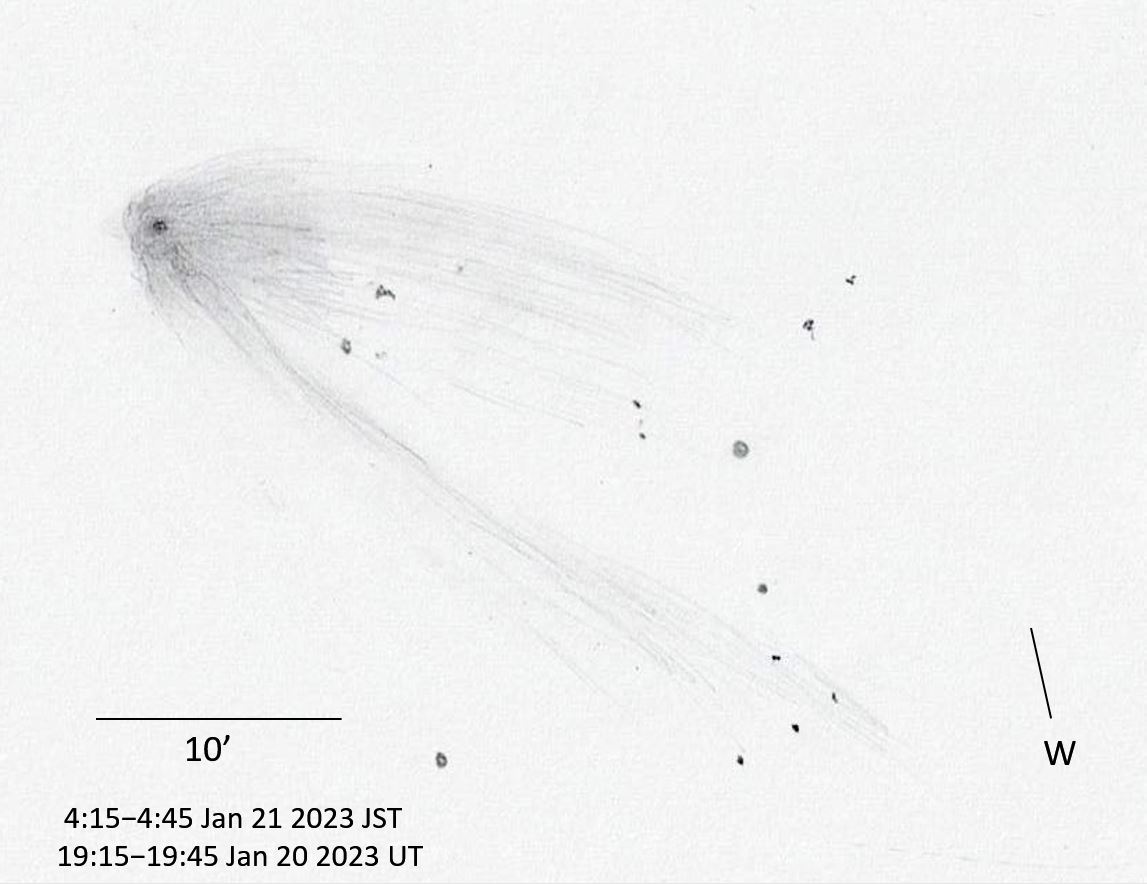
|

|
Sketch of C/2022 E3 ZTT Part 1. 46 cm NV 37x.
I had a plan to draw a sketch of this comet this predawn using my 46 cm
telescope with NV 37x prior to the comet hunting session. The first
impression when I aimed my telescope at the comet was that weirdness of
the short tail as short as 40’ (refer to the sketch). I wondered if the
cause was slightly poor transparency of the sky, but it is unlikely
because NV has a tolerance for hazy sky condition due to the extended
sensitivity up to infrared area. Anyway, the length had become shorter
without doubt. Later, I have learned there was a hypothesis on the
reduction of the length via comets-ml. That said the cause was cut-down of
the tail due to solar plasma polarity reversal originated from recent
solar flare. Comets have a magical power to transform!
Observation by Nick James: C/2022 E3 (ZTF) tail disconnection
https://britastro.org/observations/observation.php?id=20230119_050633_78f45e993ca88cf6
Today’s hunting session
After making a sketch, I started one-and-a-half-hour hunting session
from Zubenelgenubi, α Librae. There are many galaxies are with 11th
magnitude or darker in the constellation of Libera, but few of them are
detectable during the session if the sky condition is not good. Thanks to
the aid of NV I could identified seven galaxies in total: NGC5898, 5893,
5796, 5878, 5861, 5915 and 5916. Among them the darkest one was NGC5916
with the magnitude of 13.5. Those galaxies along with a diffused globular
cluster NGC5916 came into the FOV within 30 minutes from the beginning of
the session. In the latter half of the session, I observed 10 globular
clusters in the constellation of Scopius and Ophiuchus. One of them,
NGC6144, is close to Antares, α Scorpii, and one may overlook it dazzled
by the brightness of Antares even if the 46 cm telescope is used. Twenty
five minutes after the start of the twilight, I identified the last
globular cluster during the session, M107, in Ophiuchus.
Although air temperature was -3ºC, I felt it was very cold due to weak
wind. Continuing yesterday, I drew a sketch of C/2022 E3. This time I
prepared printed map and sketched on it. I noticed the length and the
shape of the tails varied in comparison with those of the previous day at
a glance. The ion tail extended to 1º in length with a branch downwards.
The dust tail also had a branch that looked like a part of an anti tail.

|
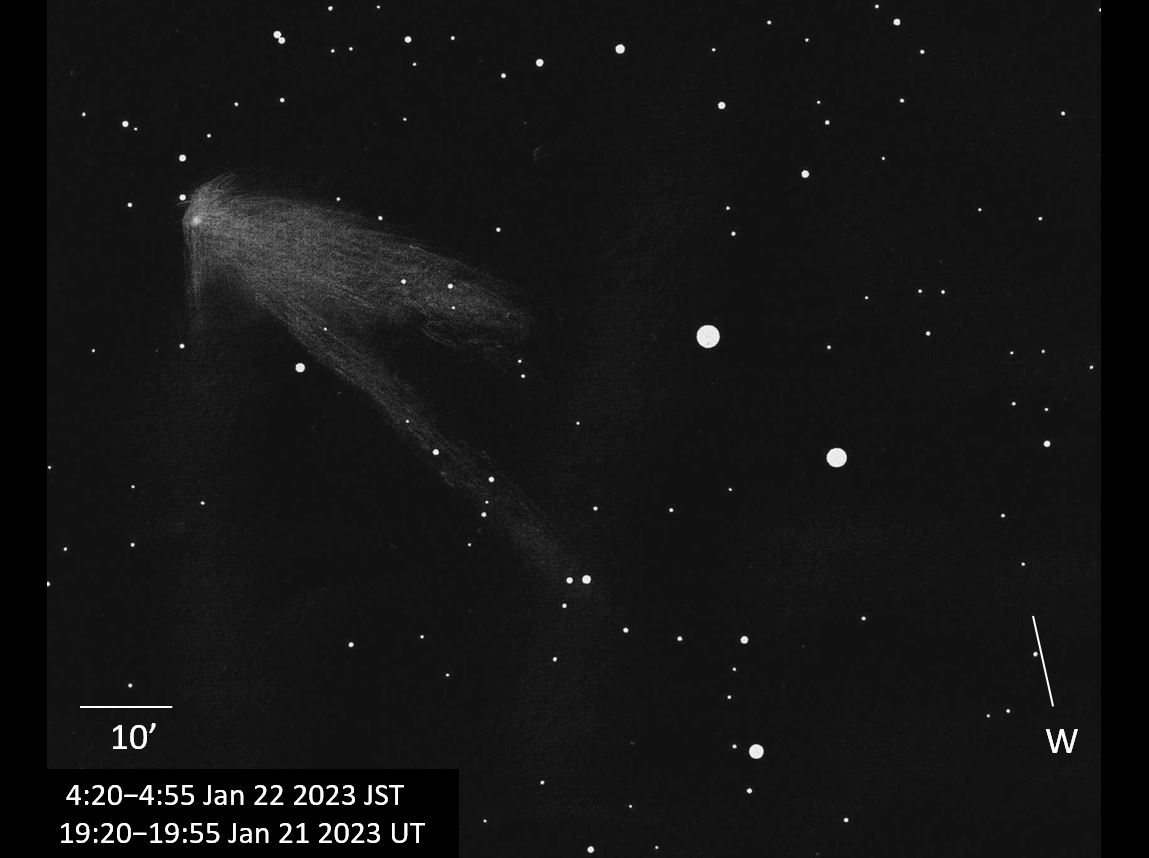
|
Sketch of C/2022 E3 ZTF Part 2. 46 cm NV 37x.
I began to sketch at 4:20a.m., however, the comet was disappeared because
of clouds at 4:35a.m. I resumed to draw the sketch at 4:45a.m. as clouds
parted; I noticed the distribution of the brightness in the ion tail was
apparently different from that at the beginning of drawing. The movie
taken by Nick James showed variation in the ion tail during one hour, and
I have confirmed similar temporal variation visually. If I had not been
interrupted by the clouds and forced to stop drawing, I would not have
noticed the change. Though I could not draw the change, I was amazed and
impressed by the fact that I detected the short time variation in the tail
visually.
At 4:47a.m. when I completed sketching, clouds increased. At 5a.m.the sky
got completely cloudy. I had been waited for clear sky until 6a.m. just
after the start of the twilight, but after all the clouds did not break
and I could not sweep the sky. The duration of the clear sky was spent
only for drawing, but I think I have felt the joy of receiving the comet's
living light directly with my own eyes since the time of the discovery of
332P Ikeya-Murakami.
Top of this page

























